Celebrating Rural America Since 1882
COOK WITH FIRE




Serve Up Flavorful Food Over a Campfire, Grill, or Woodstove




Classic Summer Recipes: FRIED GREEN TOMATOES, HOMEMADE ICE CREAM, AND OTHER SEASONAL FAVORITES

Secure Your Home and Property



See #23 on page 57










On the Cover
17 Sweet and Savory Summer Classics
From homemade ice cream to grilled hot dogs, enjoy some of the quintessential foods of summer.


20





Protecting What You
Have



A combination of feasible home and property security measures will help deter trespassers with ill intentions.
30 Cooking with Fire

Warm up to these longtime cooking techniques and serve up flavorful meats, stews, breads, and more.

Garden
and Kitchen
26 Cation Exchange Capacity in the Garden


Learn how you can improve your soil’s cation exchange capacity to grow healthier, more nutrient-dense crops.
42 Outstanding Okra: A Succulent Summer Staple
Add this hardy and bountiful crop to your garden for stunning blooms and delicious produce.
Farm and Pasture
36 Manage Healthy Grassland
Keep the grass greener on your side of the fence with these techniques for promoting productive pasture.
70 Bulls on the Farmstead
Any large animal can be intimidating, but bulls are a breed apart. Don’t let their frightening reputation stop you from taking on one of these beneficial beasts.

Forage and Survival

46 Build Your Own Survival Kit

A short list of emergency gear can help keep you prepared for those times when danger threatens outdoors.

51 Chasing Chicken of the Woods
A great-tasting mushroom awaits you in the woodlands. This “chicken” needs no defeathering or deboning — just pluck it from a dead tree.
58 Responding to On-Farm Accidents
Knowing how and when to administer aid could help save lives.
VOLUME 141, ISSUE 4

ISSUE EDITORS
ALLISON SARKESIAN, Senior Editor

OSCAR H. WILL III, Editor at Large EDITORIAL TEAM
INGRID BUTLER
KARMIN GARRISON
REBECCA MARTIN
JESSICA MITCHELL
ILENE REID
BEN SAUDER
AMANDA SORELL
JEAN TELLER
CARLA TILGHMAN
ADVERTISING DIRECTOR
BRENDA ESCALANTE; BEscalante@OgdenPubs.com
ART/PREPRESS
SHELLY BRYANT, Art Director
WEB AND DIGITAL CONTENT
TONYA OLSON, Digital Content Manager
DISPLAY ADVERTISING
800-678-5779; AdInfo@OgdenPubs.com
CLASSIFIED ADVERTISING
866-848-5416; Classifieds@Grit.com
CUSTOMER CARE 866-803-7096
CustomerService@OgdenPubs.com
TAKE A DIP
■ During the dog days of summer, a good swimming hole can solve a lot of life’s problems. Or, it can make you forget about them for a while, anyway. After a long day of work or play or maybe right in the middle of it taking a dip in cool water is about as good as it gets.
When I was a kid, my siblings and friends and I would take off on summer days and spend hours playing in a creek that ran through my family’s property. We’d see all manner of crawfish, snakes, turtles, and frogs, and we’d spend the day hopping around on the slippery rocks. If we hadn’t wandered to the creek barefoot to begin with, we’d ditch our shoes when we got there and jump in, clothes and all. We wouldn’t be allowed back in the house with wet clothes, but we knew we’d sun-dry before we made it back at dinnertime anyhow.
BILL UHLER, Publisher
MARISSA AMES, Editorial Director
CHERILYN OLMSTED, Circulation & Marketing Director
BOB CUCCINIELLO, Newsstand & Production Director
BOB LEGAULT, Sales Director
TIM SWIETEK, Information Technology Director
ROSS HAMMOND, Finance & Accounting Director
Grit Magazine (ISSN 0017-4289)

July/August 2023, Vol. 141, Issue No. 4. Grit is published bimonthly by Ogden Publications, Inc.,
1503 SW 42nd St., Topeka, KS 66609-1265.

Periodicals Postage Paid at Topeka, KS and additional mailing offices. POSTMASTER: Send address changes to Ogden Publications, Inc.,
1503 SW 42nd St., Topeka, KS 66609-1265. For subscription inquiries call: 866-803-7096
• Outside the U.S. and Canada, call 1-785-274-4361 • Fax: 785-274-4305
SUBSCRIBERS: If the Post Office alerts us that your magazine is undeliverable, we have no further obligation unless we receive a corrected address within two years.
©2023 Ogden Publications Inc.
Printed in the U.S.A.
In accordance with standard industry practice, we may rent, exchange, or sell to third parties mailing address information you provide us when ordering a subscription to our print publication. If you would like to opt out of any data exchange, rental, or sale, you may do so by contacting us via email at CustomerService@ OgdenPubs.com. You may also call 866-803-7096 and ask to speak to a customer service operator.
We also had a large pond on the property, but during the hottest days, it was often occupied by a herd of cows wading in the shallow parts, and I wasn’t interested in fighting for space with bovines. Plus, on more than one occasion, we encountered large snapping turtles in the yard or pasture making their way to or from the pond. So, all in all, my younger self found it best to avoid the pond altogether for swimming purposes. But the creek was shallow, clear, and notably bovine-free.
Although, I do recall one encounter in the creek that gave me quite a scare. I was drying off on a rock that sat a few feet from the water’s edge. It was large, flat, and often directly in the sun, so it provided the ideal spot to drip-dry before heading back to the house. I’d been lying on the rock with my eyes closed for a while, when I happened to glance over and see a huge snake curled up not 6 inches from my head. It must’ve desired the prime sunbathing spot as much as I did and slithered up while I had my eyes shut. I jumped up so fast that I fell back into the creek. It was likely a harmless water snake (we have several in this part of Kansas), but I wasn’t taking any chances. The snake, completely unbothered by my presence and activity, continued to sunbathe without a care. It was a while before I was brave enough to get on that rock again.
These days, I spend a lot less time splashing around in creeks. The spot from my childhood is still there, marine inhabitants and all, but it’s been quite a few years since I hopped in barefoot-first. As we’re approaching the hottest time of the year here in Kansas, my thoughts are drifting to the sweet relief of that cool creek water. Perhaps I’ll pay it a visit this summer.
I hope you find time this season to wash your cares away in a swimming hole, and may it be snake- and cattle-free. Drop me a note with your summer plans; I’d love to hear about them!
Allison Sarkesian ASarkesian@OgdenPubs.comTHE BEST OF TIMES
Take a trip down memory lane with time-honored tales from our readers.
 By Jean Teller
By Jean Teller
Readers, with the start of our new nostalgia department, The Best of Times, we wanted to take this opportunity to share the history of GRIT. We often get letters from readers asking if this is the same publication they delivered newspapers for years ago, and we’re happy to say it is!
— GRIT Editors









When the first headline for GRIT was set in 1882, it’s doubtful anyone could’ve envisioned the publication continuing into the 21st century.
Dietrick Lamade was a 23-year-old assistant press foreman for the Williamsport, Pennsylvania, newspaper the Daily Sun and Banner. In December 1882, the newspaper began a Saturday edition titled GRIT, which included local news items, editorials, and humorous tidbits. Dietrick set the first headline for the new edition.
The Birth of GRIT
Dietrick was born Feb. 6, 1859, in Gölshausen, BadenWrüttemberg, Germany, the fourth child of Johannes and Caroline Lamade. When he was 8, the family immigrated to the United States. Less than two years after the family settled in Williamsport, Johannes died, leaving Caroline to care for nine children. The older children went to work to help support the family, and young Dietrick apprenticed at a local German weekly newspaper. He spent the next 10 years working in newspaper offices and printing plants, including the Daily Sun and Banner and its GRIT edition.
In 1884, the young man seized the opportunity to help revitalize a small weekly newspaper, The Times. However, the man who
purchased the paper became ill and put the physical plant on the market. At the same time, Daily Sun and Banner staff were planning to end GRIT
Dietrick persuaded two men — the editor of GRIT and a printer — to join him in a partnership to purchase GRIT’S name as well as The Times’ printing plant. They intended to launch GRIT as an independent Sunday newspaper.

No one seems to know how the name “GRIT” came to be. But it wasn’t just the paper’s name; sheer grit was also how the newspaper survived those early years. After the first year, Dietrick had bought out seven of his partners, and the newspaper maintained a mountain of debt, even though circulation continued to increase.
Expanding Readership

Dietrick knew local readership wouldn’t be sufficient to keep the new publication going, so he began traveling the region searching for sales agents and news correspondents.
During one of his trips in 1885, an idea was born. Dietrick sold his partners on a contest — still legal in those days — in which readers would send in coupons for chances at winning various prizes. The drawing was held Thanksgiving 1885, with three out-of-towners and two local subscribers winning the five grand prizes. When the dust cleared, GRIT had 14,000 subscribers and $400 in the bank — with all bills paid. The partners gave themselves a raise, from $12 a week to $15.
It was about 1891 that Dietrick hit upon another grand idea: employing newsboys to sell GRIT directly to the public. After that, the newspaper began to expand to small towns across the country. By the time GRIT celebrated its 50th year in 1932, circulation was

If you have a nostalgic story you’d like to share, send an email to Letters@Grit.com, or mail a letter to 1503 SW 42nd St., Topeka, KS 66609. We’d love to hear from you!

up to 400,000. What had started as a one-room business with six staff members now employed 200 people.



The special celebration brought with it a flood of letters and telegrams from prominent and well-known men across the country. All had begun their careers as GRIT newsboys.
“Among [Dad’s] greatest joys of accomplishment was the army of business and industrial leaders who gained their first commercial experience, lessons in honesty and integrity, and the value of selfapplication, by selling GRIT in their hometowns,” said George Lamade, Dietrick’s son, in a 1952 write-up of GRIT’s history. GRIT continued to be sold by newsboys until the 1970s. Notably, 30,000 carriers delivered more than 700,000 copies to homes during the 1950s.
The Lamades continued to lead GRIT as the decades went on. Dietrick passed the title of general manager onto his son George in 1936, and then began to enjoy his retirement.


“Working at Dad’s elbow, I soon learned why he held in such high regard those people living in small-town America,” George recalled. “To compete with metropolitan dailies or national magazines was never Dad’s aim. He wanted only to serve those villages and hamlets removed from the influences of big cities. … GRIT has had, for many years, the largest concentration of circulation in small towns of any publication.”
Dietrick continued to keep in close touch with the business until 1938, when he passed away at 79.


Changing with the Times





Perhaps GRIT’S resiliency is in part due to its adaptability. In 1944, GRIT switched from a broadsheet to a tabloid-sized newspaper. At the time of the magazine’s 75th birthday in 1957, there were three editions: a Williamsport and area edition with a circulation of 40,000; a Pennsylvania state edition with 112,000 subscribers; and the national edition, which reached some 728,000 subscribers. The magazine’s circulation hit its high point in 1969 with 1.5 million subscribers.

GRIT was also a leader in the introduction of offset printing, and it was among the first newspapers to use color photographs, running a full-color picture of the American flag on the front page in June 1963.






The Lamades remained at the helm of the family business until 1981, when GRIT was purchased by ADVO System Inc. in Connecticut. Then, two years later, Stauffer Communications of Topeka, Kansas (which already owned Capper’s Weekly, a national tabloid that began in 1879 and had an audience similar to GRIT’S), purchased the magazine. After 111 years in Williamsport, GRIT moved to Topeka in 1993. Both GRIT and Capper’s Weekly were eventually sold in 1996 to Ogden Publications, owned by Ogden Newspapers, based in Wheeling, West Virginia. Today, GRIT enjoys a print and digital readership of nearly 900,000.




Moving Forward
GRIT is now in another phase of its rich history. Having entered the market of lifestyle farming after years of publishing more nostalgic content, the magazine returned to its rural roots, honoring the joys of contemporary country life. Dietrick himself wrote about this same sentiment in one of his notes to his sons:
“Wherever possible, suggest peace and good will toward men. Give our readers courage and strength for their daily tasks. … By such a
READER TIPS FROM RURAL AMERICA
This idea came from my mother-in-law. This device makes it easy to dry several small items in minimal space. It’s easy to construct using a coat hanger, zip ties, and clothespins.
 DONALD PRYOR CENTRAL CITY, KENTUCKY
DONALD PRYOR CENTRAL CITY, KENTUCKY
Recycled Root Cellar
I picked up a free nonworking freezer at the dump and then buried it in the ground. I use it as a root cellar to keep root vegetables fresher longer in the hot Florida weather.
CRAIG GRODMAN LEHIGH ACRES, FLORIDASeed-Starting Tips



I reuse toilet paper rolls for seed starting and planting. I cut four slits in each roll, about 11⁄2 inches high, and then fold the flaps to seal the bottom. I then fill the rolls halfway with soil, drop a seed in, and fill them the rest of the way with soil. I place the filled rolls in an empty egg crate to stand them up. I keep them watered, and when the seeds are ready to plant, I plant the whole tube in the ground.

I have a tip for corn on the cob season. To easily cut off kernels, place the stem end of a corn cob in the center hole of an angel food cake pan, and then slice downward with a knife to remove the kernels. The kernels will fall into the cake pan. It’s easy and mess-free.

I also save plastic strawberry trays to create little greenhouses. I fill the trays halfway with soil, plant seeds, fill them the rest of the way with soil, sprinkle water on the soil, and close the lid. They act as greenhouses until I’m ready to plant the starts.
KIMBERLEEHINKLE FRANKFORT, INDIANA
If you have garden, farm, or home advice you’d like to share, send an email to Letters@Grit.com, or mail a letter to 1503 SW 42nd St., Topeka, KS 66609. We pay $25 for each tip we publish.

 DIANA JOHNSON LIMA, OHIO
Small-Space Dryer
Corn Kernel Catcher
DIANA JOHNSON LIMA, OHIO
Small-Space Dryer
Corn Kernel Catcher


DIGGIN’ SWALES
Bust out your earth-moving tools to add swales to your property, which will boost the quality of your land.













 By Oscar H. Will III
By Oscar H. Will III
■Water management is a critical component to conservation, and when used effectively, it can significantly increase the production value and habitat quality of your land. Strategically placed swales are one of the easiest ways to enhance your drought resilience and vegetate the more arid zones in your landscape.

Swales are shallow trenches or waterways created to channel and trap or slow the movement of surface water. From the short linear depression that channels runoff from your downspouts to a water garden or pond, to a much larger earthwork that’s installed transverse to the slope in your south 40, swales can help you keep more of the water that falls on your place, on your place!
Swales can be vegetated or not. Vegetated swales are arguably more beneficial, because they have silt- and water-filtering capabilities, but if you’re in arid zones, your swales may begin as bare earthworks. In time, they may become vegetated, produce food, and increase habitat diversity.
In addition to cleansing water and delivering it to storage facilities, swales also contribute to recharging the groundwater in their immediate vicinity and downhill. Many so-called “bioswales” are created level to capture and retain surface runoff so more water will percolate to charge the groundwater. Installing a swale can help convert a dry slope to a highly vegetated, moist habitat.
An Ounce of Planning
When installing swales, having the right tools makes all the difference. You can install small-scale swales, such as in a sloped backyard, with hand tools, but you’ll want to bring in some machinery if your project is of a moderate scale. Large-scale projects often require hydraulic excavators and dozers.
Large or small, a swale project should be marked out so you know where to dig. You can use surveying tools, laser levels, and the like to lay out the swale along larger contours. Those tools will allow you to build level or sloped earthworks. For smaller projects, or even for the larger ones, you can build an A-frame level to manually mark your swale line. In
Legal Considerations

Before embarking on any earthworks project or water-diversion initiative, research ordinances in your municipality. In some places, surface water is considered a public commodity, so any modification to the “normal” flow needs approval. County agencies, the Army Corps of Engineers, and other organizations might have a say in the matter. For example, in some places, collecting rainwater isn’t legal, although it’s likely fine to swale the water to divert it to your garden.
In some instances, your swale might divert runoff that sufficiently reduces the value of your neighbor’s pond or the flow of a creek, and thus it could capture the attention of the Army Corps. The Corps has universal permits that encompass smaller projects and don’t require engineering drawings to get. In some areas, bioswales might become classified as wetlands, which come with their own set of rules and regulations. In any case, a bit of research coupled with a risk-and-benefit analysis is in order. You’d hate to invest in a project only to have it torn out because of some technicality, or to lose control of a portion of your land to outside conservation interests.
either case, take some care with this step, because the final result will depend on how level or mildly sloped your swale is. Once marked to your satisfaction, it’s time to collect the tools, labor, and fortitude to begin the build.


Breaking Ground
Before you start digging in earnest, be aware that most successful swales are at least three times as wide as they are deep. They can be wider to no ill effect, but if they’re narrower, the surface area for water percolation and retention volume will be diminished. You’ll want to keep the swale edges sloped very gradually to avoid erosion, although in practice, this isn’t always easy to accomplish with hand-dug swales. With a few heavy rains, it usually sorts itself out.
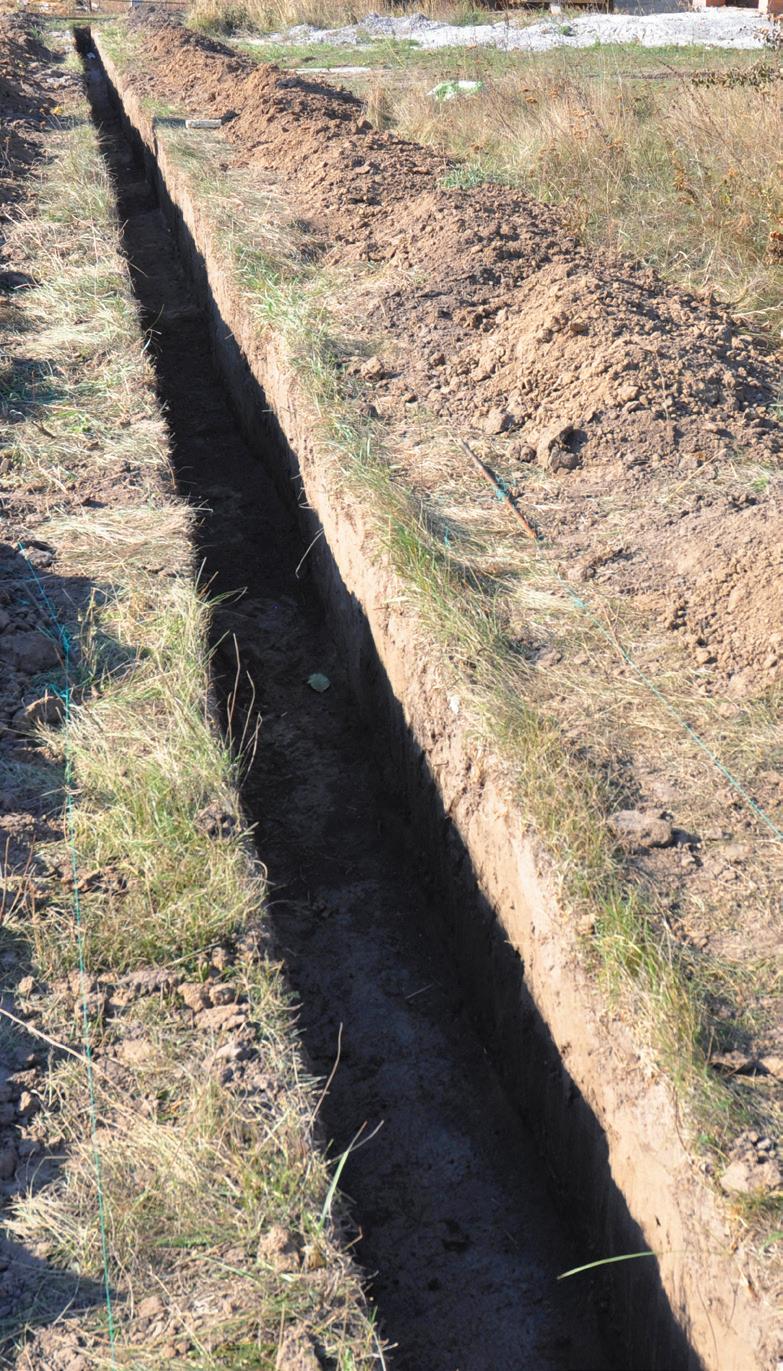
Whether you’re using a pick, shovel and mattock, backhoe, plow, or dozer, the general approach is to excavate a trench along your contour line while pulling the soil to the downslope side of the trench to create a berm. One edge of your swale will be the slope of the undisturbed land, while the other will be the berm.
Swales can range in width from a few feet to 20 or more feet, depending on specific circumstances. On gently sloped swales, you’ll want the outlet to be in an area that’s relatively flat and well-vegetated to prevent erosion, or to have it feed into a pond or series of them. Bioswales will need one or more flat spots in the berm where water can overflow during times of heavy runoff. These spillways will protect the integrity of the berm and should be located where the overflow is least likely to cause erosion.
For larger projects, a loader-backhoe tractor will likely be the fastest, most versatile method. If the slopes are sufficiently gentle, you might be able to find an old terracing plow to run along the contour using your tractor. If you’re good with a dozer, or have a friend who is, it’s possible to install 1,000 feet of swale in a day or two in prime conditions. Likewise, it might make sense to hire a pro with a large hydraulic excavator for bigger projects on steeper slopes.
Adding Vegetation
Plant the swales’ berm and downhill from it with soil-holding grasses, forbs, and trees appropriate to your bioregion. Many folks choose fruit trees, while others use shrubby species that can be grazed, such as willows, or berries, which provide food. It all depends on your circumstances and needs.
Plant the swale itself when sloped; choose a grass mixture proven in agricultural waterway projects. Shrubs can also effectively reduce erosion issues within the swale. In any case, the vegetative focus should add diversity and habitat to the landscape that’ll serve wildlife and humans alike. On small projects, hand-planting works well. On larger projects, you can use your tractor with a seeder or drill to plant the berm. Planting trees can be as easy as sticking willow or cottonwood twigs into moist soil in early spring, or you can use hand tools and power diggers to plant larger-rooted specimens in virtually any season.
Creating swales for water conservation, habitat creation, and climate modification can be rewarding in both the long and short run. And with the right tools and equipment, it’s a project you can tackle confidently. Remember, small steps can make a big difference, and the best time to get started was yesterday.
Oscar H. Will III and his wife, Joanna, run a diversified sheep ranch, where they’ve relied on miles of swales to prevent erosion, to recharge the groundwater, to increase amphibian populations, and to modify the prairie plant and soil matrices to enhance diversity.

































PHOTOS TAKEN BY THE GRIT COMMUNITY









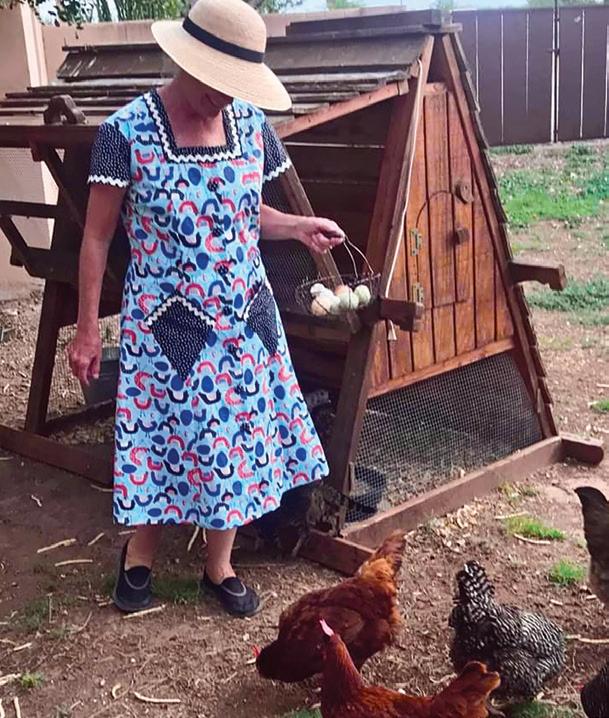

ELK CROSSING
I just read “Sharing Space” in the March/April 2023 issue. As you can imagine, with a property in Montana, we have animals — at this time, all of them wild. Some are big and hard on stuff.
We bought 11 acres in the Bitterroot Valley in 2019, and in all of our tramping, work, fence-building, weed-spraying, and enjoying the property, we never saw a single elk dropping. We knew elk lived nearby, but it became apparent they were very close this past fall when I went out early one morning to retrieve the truck we keep parked on the property and I heard elk bugling. If you’ve never heard a bull elk bugle in the wild, you’ve not experienced life yet. It’s the most magical sound in all of nature.
While it was fun to hear, I had no clue we’d be visited by said elk later that fall. You printed an article we wrote about rock fence posts (“Solid Stonework: Building Thrifty Fence Posts,” March/ April 2023), and you may have been able to discern in the photos some of the wire we attached to the posts. Let me tell you, elk are really hard on fences. An elk herd passed through the property on two different occasions. They came across at the same location both times and, fortunately, only broke the top wire on our new fence. Based on the tracks, there were 15 to 30 animals.



The first time they came across, I was out early in the morning deer hunting. I saw a large track in the fresh snow and thought,








“Wow, that must be a huge buck.” Upon closer examination, it was too round to be a deer, and, while not huge, it was much larger than any deer track I’d seen. Of course, combined with the elk bugling I’d heard earlier in the season, I recognized that an elk had passed through. I thought it odd that a single elk (probably a calf) had wandered through the property. A short hike up the hill a few minutes later showed me this was no lone calf. An entire herd had crossed over, including what was most likely a very large bull.
Now, we can say we have elk in addition to quail, rabbits, deer, ground squirrels (wretched creatures), voles, doves, woodpeckers, snakes, and myriad other life on our 11-acre parcel. It’s incredible.
The photos show the elk track in the snow and the spot where they came over the fence. If you look carefully, you can see the top wire hanging loose on the fence. The Montana Fish, Wildlife, and Parks Department has an entire pamphlet on how to build wildlife-friendly fences. One thing we’re adding to the top wires of our fences is small metal tabs so animals can see the wire at night. So far, so good. Everywhere we’ve put the tabs, the critters either manage to go over or around without damaging the fence.
 WARD M. THURMAN MONTANA
WARD M. THURMAN MONTANA

Looking For
Finnish Bread Recipe

Approximately 55 years ago, I found a recipe for Finnish bread in the Grit newspaper my parents subscribed to, which was delivered by a neighborhood boy. The recipe made two round loaves and was a great complement to pasta meals. Do any readers have that recipe?
ROBIN KOBLE VIA EMAIL
Small and Fierce
“My aunt shared some issues of Grit with me recently, and I saw your “Sharing Space” editorial (March/April 2023).
I remember reading Grit when it was a newsprint publication that my grandparents subscribed to in the 1970s. I always enjoyed it when I visited, and I would read it front to back. I thought I’d do the same with the March/April 2023 issue my aunt gave me, and I saw your suggestion to drop a note on the creatures in my life.
I took this photo while walking near a lake tributary. My yellow lab, Sammy, was intrigued by the small yet erce creature that was in her path. That crawdad sure was trying to be brave when staring down the nose of such a big animal. The little guy won, as Sammy had better things to do, such as nish the walk to earn her treat.

Thanks for being part of a great publication! I’m glad my aunt reintroduced me to Grit
CHRISTY LONERGAN VIA EMAILGRIT in the Family
I’m writing in regard to Grit, both old and new. My nephew used to sell Grit papers when he was young. The publication back then was a newspaper, but it was very informative and still is. I really enjoy it very much. He had a lot of customers and worked hard, riding his bicycle and walking to deliver the papers.
DIANE CHANDLER PARIS, TENNESSEEShare Your Thoughts
We welcome letters from our readers. If you’d like to comment on an article, share your opinions, or submit a “Looking For,” send us an email (with photos, if available) to Letters@Grit.com, or send a letter to: GRIT Mail Call, 1503 SW 42nd St., Topeka, KS 66609. Electronic submissions are more likely to receive a timely response. Readers assume all risk associated with publishing a mailing address, requesting correspondence, and responding to correspondence requests in GRIT magazine.
PEN PALS
I’m seeking pen pals. I’m a lifelong organic farmer, as well as a wife, mother, and grandma. I love wildlife, feeding and watching birds, reading, gardening, and praying. I’d like to send and receive postcards.
Arlene ShakoBrentwood Farm 624 Knox Road Schoharie, NY 12157
PEN PALS
I’m a home-schooling mom revitalizing a farm with two kiddos who love to learn along with me! We love stories, recipes, nature, crafts, and all things farm life. The kids love to receive mail, or you can follow our farm on Instagram or Facebook, @EurekaMoonFarm (www.linktr.ee/EurekaMoon).
Mandy, Brooke, and Liam Webber 1588 Eureka Ave. West Branch, IA 52317
BIRDS & BLOOMS MAGAZINES
I have many Birds & Blooms magazines to give away. I’m looking for someone who enjoys and loves birds. If you’re interested, I’ll pay postage.
Beckie Almquist
40140 116th Ave. Way Zumbrota, MN 55992

PEN PALS



I’m looking for women pen pals. I’m retired and have a farm with animals and a garden. I love to read, cook, and do sewing projects, especially crochet. I have 14 grandchildren. I’m looking to share my interests and learn about yours.
Lorraine
MichaelP.O. Box 1121 Monroe, NC 28111
Sweet Summer Memories






In response to “Farewell to Summer” (September/October 2022), it sounds like Allison’s childhood was much like mine. Riding our horses into town was the big social event for my friends and me. We’d also go camping out in the backyard, as well as shing. I had such a wonderful childhood back when kids could still be kids, and you could still play in the backyard until Dad called you in, usually around 9 p.m. We went nightcrawler hunting and would catch lightning bugs; play on tire swings and teeter-totters; stay up late to watch Creature Features on an old black-and-white TV; and go to the pool, where we’d spend hours and hours in chlorinated water. I so wished for that sort of childhood for my kids, but sadly, that’s not the world we live in.


I always feel low when the days grow steadily shorter and the shadows longer. My daughter loves fall and simply can’t understand my sad moods. So many people claim fall is their favorite season, but I’m not one of them. The memories of summer are too sweet and precious.

SWEET AND SAVORY SUMMER CLASSICS
From homemade ice cream to grilled hot dogs, enjoy some of the quintessential foods of summer.
 By GRIT Editors
By GRIT Editors
■Summer is the season of fresh produce, backyard barbecues, and camp re cuisine. And while “classic” can mean many things to different people, we’re using it in this context to share a few of our often-requested recipes that have stood the test of time. Most of these recipes come from the archive of Capper’s Farmer, our sister magazine, and were submitted by readers dating back to the 1920s. We hope you enjoy them and maybe spend some time reminiscing on your favorite summer pastimes.
HOMEMADE ICE CREAM
This recipe was submitted by Grace W.
It was originally published in 1929. You can include fruit or other flavor add-ins if desired. Yield: 1 gallon.
1 quart whole milk, plus more as needed
4 eggs yolks
2 cups sugar, divided
1 heaping tablespoon flour
1 tablespoon vanilla extract 2 teacups cream (scant 11⁄2 cups)


1. Combine 1 quart milk, egg yolks, 1 cup sugar, and flour in a large pan. Heat mixture slowly over medium-low heat until it reaches a temperature of 140 F and thickens.
2. Add remaining sugar, vanilla extract, cream, and enough additional milk to fill a 1-gallon freezer-safe container to within 3 or 4 inches of the top.
3. Chill mixture for several hours in refrigerator.
4. Churn in an ice cream machine. Alternatively, freeze mixture in freezer-safe container until solid.

DILL POTATO SALAD
This recipe was submitted by Mrs. George Ebsen. It was originally published in 1970. Yield: 8 servings.

1 quart cooked, diced potatoes
1⁄2 teaspoon salt
1⁄4 teaspoon pepper
1 tablespoon chopped onion
1 cup peeled, diced cucumber
1 cup diced celery
2 hard-cooked eggs, chopped
2 tablespoons dill seed
2⁄3 cup mayonnaise
1. Combine potatoes, salt, pepper, onion, cucumber, celery, eggs, and dill seed; blend well.
2. Add mayonnaise and mix thoroughly. Chill well.
PERFECT PEACH COBBLER

This recipe was submitted by Mrs. P.B. Brothers. It was originally published in 1988. Yield: 4 to 6 servings.
3 cups sliced fresh peaches
1 cup plus 3 tablespoons sugar, divided
1 teaspoon grated lemon peel
1 tablespoon lemon juice
1⁄4 teaspoon almond extract

11⁄2 cups sifted flour
2 teaspoons baking powder
1⁄2 teaspoon salt
1⁄3 cup shortening
1 egg
1⁄2 cup milk
Whipped cream or ice cream for topping
1. Arrange sliced peaches in a 9-inch round baking dish. Mix 1 cup sugar, lemon peel, lemon juice, and almond extract; sprinkle over peaches. Bake at 400 F for 10 minutes.
2. While peaches are cooking, sift together flour, 1 tablespoon sugar, baking powder, and salt. Cut in shortening. Beat egg and mix with milk; add egg and milk to dry ingredients, mixing just enough to moisten.
3. Drop dough over hot peaches, spreading slightly with back of spoon. Sprinkle with remaining 2 tablespoons sugar.
4. Bake an additional 30 minutes. Top with whipped cream or ice cream, if desired.
CORN AND CRAB CAKES

This recipe was originally published in 1988. Yield: 4 to 6 servings.
1 cup sour cream
1 tablespoon Dijon mustard
1 tablespoon milk
1 can (4 ounces) green chiles, undrained
1 pouch (10 ounces) frozen whole kernel corn in butter sauce
1 teaspoon dry mustard
1⁄8 teaspoon cayenne pepper
1⁄4 cup mayonnaise or salad dressing
1⁄4 teaspoon Worcestershire sauce
2 eggs
3 cups soft bread cubes
1 can (6 ounces) crab meat, undrained
1⁄4 cup oil, divided
1. Combine sour cream, Dijon mustard, milk, and green chiles in a small bowl. Mix well, and set aside.
2. Place unopened corn pouch in warm water for 20 minutes to thaw, or cut a small slit in center of pouch and defrost in microwave for 5 minutes or until thawed.
3. In a medium bowl, combine dry mustard, cayenne, mayonnaise, Worcestershire sauce, and eggs; beat well. Stir in corn, bread cubes, and crab meat; mix well.
4. Heat 2 tablespoons oil in a large skillet. Pour in 1⁄3 cup corn mixture and flatten slightly. Cover and cook over medium-high heat for 4 to 5 minutes, or until set. Carefully turn over with a spatula. Cover and cook for 21⁄2 to 4 minutes longer, or until golden-brown. Repeat with remaining oil and corn mixture. Serve with sour cream mixture.
FRIED GREEN TOMATOES

This recipe was submitted by Mrs. M. Pierce. It was originally published in 1931. Yield: 2 to 3 servings.
1 egg
1 tablespoon sugar
1⁄2 cup milk
1 teaspoon baking powder
Salt, to taste
Flour, enough to make a thin batter
Green tomatoes, sliced 1⁄4 inch thick
Fat, for frying
1. Combine egg, sugar, milk, baking powder, and salt. Add enough flour to make a thin batter.
2. Dip tomato slices in batter, and then fry in deep, hot fat. Serve hot.
CHICKEN WALDORF SALAD

This recipe was submitted by Mrs. Esther Wells. It was originally published in 1968. Yield: 4 to 6 servings.
4 cups cooked, cubed chicken
2 tablespoons grated onion
1 cup diced celery
1 cup diced green pepper
2⁄3 cup coarsely chopped nuts
2 cups unpeeled, diced red apples
1 cup sliced grapes (optional)
2⁄3 cup mayonnaise
2 tablespoons vinegar
Salt and pepper, to taste
Crisp lettuce leaves or bread, for serving
1. Combine chicken, onion, celery, green pepper, nuts, apples, and grapes, if using, in a large bowl.
2. Blend mayonnaise and vinegar together; toss lightly with chicken mixture. Season with salt and pepper. Chill thoroughly. Serve on crisp lettuce or bread.
Few things say “summer” like a hot dog. There are almost endless ways to prepare and eat them, from the classic campfire cuisine to bold breakfast options. Get creative, and enjoy this favorite summer food. These recipes are excerpted from Hot Diggity Dog by Eliza Cross, published by Gibbs Smith.

SOUTHERN PICKLE SLAW DOGS

Yield: 8 servings.
1⁄3 cup mayonnaise
2 tablespoons dill or sweet pickle juice
11⁄2 teaspoons balsamic vinegar
1 teaspoon sugar
1⁄4 teaspoon ground mustard
1⁄4 teaspoon freshly ground black pepper
1⁄8 teaspoon salt
1 medium dill pickle, finely chopped (about 2 tablespoons)
1 tablespoon finely chopped onion
1 bag (16 ounces) coleslaw mix
8 all-beef hot dogs
8 hot dog buns
Ketchup and mustard, for serving
1. In a medium bowl, whisk together mayonnaise, pickle juice, vinegar, sugar, mustard, pepper, and salt until smooth. Add pickle and onion, and stir to combine. Add coleslaw mix, and toss with a fork to distribute the dressing. Cover and refrigerate until ready to use.
2. Preheat grill to medium-high. Cook hot dogs, turning often, until sizzling and browned all over, 6 to 8 minutes. Grill buns, cut side down, until lightly toasted, about 1 minute.
3. Place a hot dog in each toasted bun and top with some slaw. Serve with ketchup and mustard.
BREAKFAST DOGS
Yield: 6 servings.
61 ⁄2 tablespoons unsalted butter, softened, divided
1⁄3 cup all-purpose flour
3 cups whole milk, warmed
1⁄2 teaspoon salt, plus more for seasoning
1⁄4 teaspoon freshly ground black pepper, plus more for seasoning
1 cup shredded sharp cheddar cheese
1⁄4 cup shredded Parmesan cheese
6 hot dog buns, split
6 jumbo all-beef hot dogs
6 large eggs
1⁄3 cup half-and-half
6 strips bacon, cooked until crisp and then crumbled
Chopped fresh chives, for garnish
1. In a medium saucepan, melt 4 tablespoons butter over medium-high heat. Add flour and cook, stirring constantly, until mixture is pale-yellow and frothy, about 1 minute. Slowly add warm milk, and continue whisking until sauce thickens and bubbles, 3 to 4 minutes. Reduce heat to a simmer, season with salt and pepper, and simmer for 2 minutes. Add cheeses, and whisk until melted. Cover and keep warm over low heat.
2. Open buns and spread cut sides with 2 tablespoons butter, dividing butter evenly between buns. Heat a large skillet over medium-high heat and cook buns, buttered side down, until golden-brown, working in batches if necessary. Set aside.
3. With a sharp knife, cut hot dogs lengthwise without cutting all the way through. Gently open hot dogs and arrange on hot skillet, cut side down. Press down with a spatula and cook until browned and heated through, about 6 minutes; set aside.
4. In a medium bowl, whisk together eggs and half-and-half. Wipe out skillet, and then melt remaining butter over medium heat. Add egg mixture and cook, stirring frequently, until eggs are scrambled. Remove from heat and season with salt and pepper to taste.
5. To assemble, place an open-face grilled bun on each plate. Top with a hot dog, open side up, followed by a portion of scrambled eggs. Spoon sauce over eggs, sprinkle with crumbled bacon and chives, and serve.

PROTECTING What You Have
A combination of feasible home and property security measures will help deter trespassers with ill intentions.
 By Dana Benner
By Dana Benner

I remembera time when many rural folks never even thought about locking the doors of their homes when they left. We didn’t lock our vehicles on our own properties or worry about someone stealing our dogs or about our children playing in the yard. Furthest from our minds was the idea that people would steal food from our gardens, chickens from the coops, or even cattle in the pasture. Well, those days are behind us now. We live in a time when rural property thefts are uncomfortably common. A time when, as my father used to say, “If it isn’t nailed down, someone will take it.” It does no good to simply complain about it. It’s reality, and we need to address it. So, what do you do to protect what you have?
When we think about protecting our property, especially when dealing with livestock, our attention usually focuses on four-legged and aerial predators. We worry about coyotes, foxes, bears, hawks, etc. We deal with those assailants using dogs, fences, and, yes, even rearms when needed. Less often do we worry about two-legged predators.


If you raise livestock, have a garden, or run a full- edged farm, there will always be some loss to natural causes (predators and weather). Dealing with human predation is a different matter. Animal predation is normally food-driven; human predation, or theft, may not be. Reasons can vary, from desperation to nancial gain to simply thrill-seeking, but at the end of the day, it’s still property lost and damage done.
Some people will automatically turn to rearms to protect their property, but I have no desire to turn my home into an armed encampment. The use of rearms in any situation should always be the last resort. If you ever have to pull a rearm to protect you, your family, or your property, make sure you’ve familiarized yourself with that rearm ahead of time and feel con dent using it.
Remember, nothing you do is foolproof. If someone is intent on taking your property, they will. The good news is that most would-be criminals will
only go after easy targets. This means you should never make it easy for them. Don’t leave items out in the open. At the end of a day of work, if your property looks like you’re having a yard sale, then you’re asking for problems. Out of sight, out of mind.
Light It Up and Lock It Up
To deter would-be criminals from breaking in after dark, consider adding lights to your property. Motion-sensing lights are available almost everywhere, and they’re well worth the investment.

Even those inexpensive solar-powered walkway lights can make a difference. I have both on my property, and while I can’t say for sure if they’ve actually deterred any criminal activity, they’re just another tool in the toolbox.
Locks can also be an effective tool to use, but keep in mind that they’re a deterrent and nothing more. They’re not an absolute x, but they’re the best and easiest line of defense you have. Locks may not stop a serious intruder, but if you don’t lock your property up, then it’s in much more danger of being taken. This

goes for your home, vehicle, barn, and gates to your pastures.
Your home is your safe zone, or at least it should be. But how many people out there rely solely on the push-button lock on the doorknob? Those locks are some of the easiest to bypass, and every criminal knows it. Every door leading to the outside of your home should have at least a deadbolt lock, which take a lot more effort and time to get past. If someone is trying to break in, they won’t want to waste time cutting chains, dealing with locks, or kicking doors down. The longer they spend bypassing those deterrents, the greater chance they’ll get caught. Again, don’t make it easy for a would-be criminal. Put as many obstacles in their path as you can. Locks are just one of those obstacles.
State the Obvious with Signs
There’s a reason you see signs on people’s properties warning that the home is protected by a security system of some sort. Whether it’s true or not, criminals won’t know. What they will know is there’s a chance they’ll get caught. No matter what, make sure you post your property. Signs that say “Keep Out,” “Private Property,” “No Trespassing,” or the everpopular “Violators Will Be Prosecuted” do
actually work. Giving people fair warning may be enough to make them think twice. And depending on your state’s laws, clearly posted signage can also provide you further legal recourse in the event someone trespasses on your property.

Make sure your signs are noticeable and properly placed. On a smaller property, one or two signs may work. On larger parcels, you’ll need to make sure every gate has a sign (and lock). You may also want to space a few signs along the property line, because the first thing a potential criminal could say is they never saw any sign.

Get It on Camera
Cameras, and there are many out there, are another deterrent. While cameras on their own won’t necessarily stop intruders, what they record will help law enforcement catch and prosecute the criminals. But we’re not talking James Bond stuff here. Security cameras can be as simple or as complicated as you want. On my property, I use the same types of cameras used by hunters in the field. Other people like to use cameras that are linked to their phones so they can constantly monitor their property.
Just like with signs, cameras should be strategically located. I like using trail cameras because I can easily hide them.

Put a few along your property line and near each outside gate. Many times, potential intruders will go right up to the gate first, and this is where you’ll get them.







Having cameras in your home isn’t a bad idea either. If someone does get in, hopefully their acts will be caught by the camera. The cameras won’t stop people from taking your stuff, but they may help the police find the ones who did it, and even get your property back.

Make Your Presence Known

Constant activity on your property, whether that’s moving cattle from one pasture to another, fixing fences, haying, or even just mowing your lawn, will help keep unwanted people away. This doesn’t mean you have to be out there in plain sight every day or be confined to your property. Actually, it’s best that you aren’t. Very few of us are home all day, every day. I know there’s constant comeand-go at my home. If potential property thieves don’t know if and when someone is home, it may deter them, making them seek greener pastures.


















Work with Your Neighbors


At one time, it seemed like everyone knew their neighbors. They could be right next door or 2 miles down the road, but either way, they looked out for each other. Today, how many people can actually say they really know their neighbors beyond a simple wave? I’ve made it a point to know the folks living around me, because they’re part of my security, and I’m part of theirs.
In my line of work as a writer, I’m often away from my property. If I’m intending to be gone for more than just a day, I let my neighbors know my plans; that way, they can keep an eye on my place. They’ll look out for strange vehicles in my driveway or anything that doesn’t look normal. On one occasion, I had two neighbors confront one another while I was away because they both saw someone on my property each other. Everything ended well, and while the story makes me laugh, it also makes me feel good that folks were looking out for me.


This act of neighbor watching neighbor works both ways. One time, while one of my neighbors was away (he told me his family was going before they left), I noticed a window wasn’t closed as I drove by. I stopped and investigated. The screen had been removed and the window was open. Though I was armed, I decided to go no farther and called the police. I stayed on-site and called the property owner as well. As it turned out, my neighbor confirmed the screen had been broken before he left and that one of his kids had left the window open. The police also confirmed nobody had broken in. It all ended well, but the outcome could’ve been different.
Both instances show how important it is to look out for each other. While neither example was serious, it does show this strategy is effective.
All Working Together
Each one of these measures on their own won’t stop people from threatening
your property and livestock, but when they’re used together, they can make a difference. Wayne LeClair, owner of Rocky Meadow Farm in Francestown, New Hampshire, where he raises Galloway cattle, uses all of these measures to safeguard his property. He makes the point that “as economic issues affect food supplies, every farmer and rancher will need to take steps to protect against increasingly desperate people.”
For protecting your home and property, there’s no silver bullet. All we can do is our best to keep our families
safe and our possessions secure. If someone really wants to steal from you, they will, and no sign, lock, or camera will stop them. But all of these tools together will make it harder for them to do it and it may just help bring your property back home to you.
Dana Benner has been writing about all aspects of the outdoors and self-sufficiency for more than 30 years. His work has appeared in numerous publications.


See #20 on page 57





Cation Exchange Capacity












IN THE GARDEN

Learn how you can improve your soil’s cation exchange capacity to grow healthier, more nutrient-dense crops.

























 By Andy Wilcox
By Andy Wilcox
All of us who grow something in the soil gardeners, homesteaders, and farmers should be familiar with cation exchange capacity (CEC). It affects plant growth and vigor, the nutrient density of crops, and even disease resistance. Let’s take a peek behind the curtain.
What Is a Cation, and Why Would We Want to Exchange It?
We know our plants need nutrients to grow, flower, and fruit. Some of these nutrients are called “macronutrients” because plants need them in higher quantities. Nitrogen (N), phosphorus (P), potassium (K), calcium (Ca), magnesium (Mg), and sulfur (S) are commonly classed as macronutrients. Plants also need other nutrients in lesser amounts for proper growth and function. We call those nutrients “micronutrients,” and examples include zinc, iron, boron, manganese, and copper. You’re on the right track if these remind you of the periodic table.
Air and water are the ingredients for photosynthesis, but plants’ complex proteins, enzymes, and carbohydrates require a soup of macro and micronutrients. Those nutrients, many of which are present as ions, come from the soil.
An ion is simply an atom or molecule with a net electrostatic charge. Remember the plus and minus signs you hated in high school chemistry or biology? Ions with a net positive charge a plus sign are cations. Remember this by thinking of a housecat: They have quite a positive opinion of themselves. K+ is a positively charged potassium ion a cation. There are also negatively charged ions, like nitrate (NO3-), called anions.
Just like in magnetic fields, electrostatic charges are attracted to their opposite. A cation with a positive charge will be attracted to and stick somewhere it finds a negative charge. When a cation attaches to a soil particle, it’s adsorbed.
Soil clay particles and soil organic matter, especially the humus component (because of its chemical composition), are covered in sites with negative charges.
When a lonely cation wanders by, it’s Valentine’s Day. Our potassium ion (K+) moves around in the soil solution and sees a clay particle with a negative charge. Pow! The cation is adsorbed and is stuck to the soil particle. In this example, the potassium ion is now “safe” from leaching and loss from the soil root zone it won’t be carried away by water moving through the soil profile. That’s a good thing.
An adsorbed cation is safe from leaching but isn’t as available for direct root uptake, since it’s in the soil solution. Fortunately, adsorbed cations are easily exchanged with other cations in the root zone.
The number of charged sites available for cations to play musical chairs is the capacity part of CEC in your soil. It varies with three factors: soil texture (sand, silt, clay), soil organic matter percentage, and soil pH. CEC is measured in a soil lab and described in complex units called milliequivalents per 100 grams of soil (mEq/100g). For our purposes, you can ignore the units (don’t tell your science teacher) and say that soil with a CEC
of 6 has fewer sites and, therefore, less exchange capacity than soil with a value of 15. Higher values indicate the capacity to store more nutrients, holding them for later use by plants and preventing them from leaching away.
Factors Affecting CEC
Your soil’s texture will greatly impact its CEC. Soil organic matter levels and soil pH also play a prominent role. A soil test can be helpful to determine the original state of your soil.

Soil Texture and Organic Matter
Sandy soils are made of large, coarse particles that are mostly inert. Sand particles themselves, unlike clay, have no electrostatic charge. As a result, they have very few of those particular sites where a cation can attach. Clay and humus particles tend to have a net negative charge and many sites for cations to attach. Additionally, sandy soils have a much lower soil particle surface area in a given volume than clay soil does.
Large particles, lower surface area, and fewer charged sites mean that sandy soils have a low CEC. Clay soils have more particles, more exchange sites per unit area, and a much higher surface area. Therefore, clay soils have a higher CEC. Loamy soils are in the middle. You’ve probably been introduced to this concept by the knowledge that sandy soils are less fertile holding fewer nutrients than clay soils.

Visualize a clay soil sample as a 5-gallon bucket of marbles and a sandy soil sample as a 5-gallon bucket of basketballs. Two basketballs is all that will fit. Although the marbles are smaller than the basketballs, the combined surface area of our bucket of marbles is more than 10 times higher. Now, imagine each marble has 10 charged sites available for cations. Sand has few, if any, exchange sites, so only every other basketball has a site.
Humus has an even higher number of charged sites than clay. Depending on the type of clay, humus can have as many as 5 to 30 times more sites. Humus can truly supercharge your CEC numbers. It’s like throwing a couple handfuls of marbles in the bucket, each with 200 or 300 sites apiece.
Soil pH
The CEC for a given soil will rise as the pH rises, as long as it isn’t pure sand. Basically, the number of negatively charged sites on humus particles and some clay particles grows as the pH moves from acidic to alkaline. Because of this, most soil tests will reference CEC at a pH of 7.0 so different soils can be compared.
Soil pH is important for CEC and plant growth. You’ve likely heard that blueberries and rhododendrons love acidic soil and that most common vegetable crops grow best in a pH of 6.0 to 7.0. These preferred pH ranges have to do with plant nutrient availability and uptake, driven in part by CEC and solubility of nutrients.
Improving Your Soil’s CEC
Now that we know what CEC is and why it’s important, let’s talk about how we can improve our soil’s CEC. There are two practical ways do it this: raising the pH (if the soil is acidic), and adding more soil organic matter (SOM). Even raised beds can benefit from these methods.
Raising Soil pH
Liming is a time-tested technique farmers use to raise the pH of their fields. Gardeners can do it too. Many factors
can contribute to the acidification of your soil over time. Bringing the soil pH back into that sweet spot of 6.0 to 7.0 can help nutrient availability by easing the movement of minerals in the soil. CEC is enhanced (more nutrients can be stored), and a slightly acidic to neutral pH is also the range many beneficial soil microbes like the best. Those microbes are most active breaking down soil organic matter, releasing nutrients, fixing nitrogen, and feeding plants when the soil is closer to neutral.
Don’t go hog wild with the lime. Soil pH can take up to a year to respond fully to treatment. Several small treatments with soil testing in between are better than one large dumping. A good soil test report will help determine your current pH, the buffering capacity of the soil (how much it will resist change), and how much amendment might be needed to bring change. Some specialty crops, like blueberries, thrive in acidic soils, and raising the pH isn’t advised for them.
Adding Soil Organic Matter
Increasing the percentage of SOM in your beds, gardens, or fields is the key to higher yields, lower disease, increased drought resistance, and even better flavor from your produce. Higher
levels of SOM supply nutrients when broken down nitrogen being a primary benefit significantly increasing your CEC. Remember the marbles, and how a clay marble might have 10 exchange sites, but a humus marble can have 200 or 300 exchange sites? Here are a few ways to add some of those high-function marbles to your bucket.

Reduce Tillage: One of the easiest ways to increase SOM and benefit your soil microbial life is to park that rototiller or plow. You may think tillage is incorporating organic matter and loosening the soil, but it destroys soil aggregates, reduces drainage and aeration, kills soil microbial life, and reduces SOM. (It decomposes too quickly and is lost.)
Manure: I’m always jealous when I see a large pile of old, rotting manure at a farm. There are considerations to be aware of when adding manure, such as allowing different types enough time to rot, the addition of weed seeds, etc., but you’ll be hard-pressed to find an easier way to bring up SOM and overall fertility than properly adding a bit of manure. If you don’t have a manure maker of your own, offer to shovel for a friend.
Compost: Adding finished compost is the quickest way to see results in an otherwise mediocre garden plot. Work it into the top couple inches of soil to avoid
disturbing our soil microbe friends too much. The humus in compost will raise your CEC, and compost will improve soil structure, fertility, porosity, and even drainage. You’ll also jump-start your soil microbial population. Natural mulch will suppress weeds and eventually become SOM as well.
Cover Crops: Once you’ve added compost and maybe some manure to your soil, stopped tilling the heck out of it, kept it covered with mulch, and checked the pH, it’s time to dig in. Cover crops are a topic all their own, but their benefit, as far as CEC is concerned, is that they raise SOM levels. They can be used in regular gardens, raised beds, market garden plots, and full-scale fields. Specifics on which cover crops are suitable will depend on your crop rotation, climate, soil type, goals for the cover crop, severity of winters, and method of cover crop killing.
Understanding CEC and how to maintain or improve it is valuable knowledge. You’re empowered to improve your soil and grow more vigorous, healthy, happy crops. Growing your soil’s CEC involves holistic practices that benefit cation exchange as well as the soil microbial life hard at work behind the scenes. The effects are compounded, and you’ll enjoy the rewards.
Gardening & Homesteading


Learn the secrets of growing abundant plants and vegetables. Explore the fascinating natural world around us. Delve into a “hands-on” subject like beekeeping or mushrooms.
folkschool.org/grit
BRASSTOWN, NORTH CAROLINA
1-800-FOLK-SCH
See #8 on page 57
Andy Wilcox is a freelance writer and flower farmer passionate about gardening, horticulture, and forestry, and who believes healthy soil leads to healthy people. He can be reached at Andy@ ThatGardenWriterGuy.com




Warm up to these longtime cooking techniques and serve up flavorful meats, stews, breads, and more.
There’s likely
little that feels more timeless, visceral, and rewarding than building a re and cooking your food. In a modern world of food-delivery apps, drivethrus, and prepackaged plastic packets of passably palatable provender, there’s something about the direct relationship with ame and nourishment that reminds us of where we came from and, perhaps, connects us a little more tangibly to what it means to be human.
Fire cookery is often relegated to survival and “prepper” handbooks, but I contend it can and should be a more commonplace skill. I personally choose to cook over re through the year to provide for my family in our purposely low-tech, off-grid home. I like that the fuel for our cooking can be sourced sustainably and directly from our own land as well. After all, the majority of my cooking fuel comes from wind-fallen branches and dried prunings and trimmings, rather than split cordwood. Furthermore, quite a few dishes
are greatly improved by the sear and smoke of real re cooking.
Since I’ve had a lot of practice, I’ve come up with some ideas, tips, and tricks to share with those interested in scaling their culinary skills back to Stone-Age tech. Whether you’d like to live off-grid, or you just want to impress your friends at your next camp-out, I hope this guide to three different low-tech re-cookery methods will serve you well.
Cooking Over a Campfire
Even if you have no experience cooking, you’ve likely spent at least one starlit evening roasting marshmallows over a camp re. And if you have, you’ve probably learned one of the basic tenets of cooking over a rustic open ame: Pay attention! It’s easy to burn things into black char if you’re not watching.



In my experience, the most useful re for roasting vegetables and meat and cooking bread isn’t the roaring inferno that weekend woodland warriors are inclined to build, but a carefully controlled, barely aming bed of
FAST & EASY STUMP REMOVAL
• Efficient PTO powered stump grinder makes stump removal easy.

• Easy operation from the seat of the tractor using existing tractor hydraulic controls.

• Cutting wheel design provides a smoother cutting action for higher productivity.



• Models designed for tractors 22 -50 PTO HP and 45- 100 PTO HP.

A Radically Righteous New Take on Live-Fire Cooking
Project Fire is a stunning, fullcolor celebration of the best of contemporary grilling from an American master of livefire cooking, Steven Raichlen. Drawing on a combination of classic and boldly contemporary techniques, Raichlen presents 100 inspired recipes that capture the full range of what grillers want to cook today. Raichlen starts with the iconic T-bone grilled over direct heat and moves to reverse searing, the approach that allows you to grill a monster steak to perfection while also imparting a haunting smoky flavor. Also covered is searing meat right on the coals, blow-torching a veal chop, grilling mussels in the hay, cooking squash on a salt slab, cooking salmon steaks on a shovel over a campfire, and more.

This title is available at Store.Grit.com or by calling 866-803-7096. Mention promo code MGRPANZ5. Item #8830.
coals. You want to heat the food, not the sky, when it comes to basic fire cooking.
A good bed of coals doesn’t happen immediately, however. When cooking over a rustic open flame, you’ll need to build up a fire, let it burn for a few minutes, and then rearrange the “cooking surface” to a much more useful low glow. Use a stick or a poker to spread out the coals, hedge them in with some larger fuel pieces, and then balance your food as needed above the relatively controlled heat.
With your fire so prepared, you can now cook several delightfully simple dishes. Potatoes can be roasted in their skins. Simply poke a few vent holes through the skins (so the potatoes don’t explode!), dig some trenches in white-hot ashes, and bury them until done. The outer skins will likely be burned to a crisp, but the inner white flesh will be delectable with just a pinch of salt.
You can roast corn in its husk in the same way. I find that once the outermost leaves are burned black, the kernels within are caramelized to perfection.
Skewer meat on peeled sticks, season it with a sprinkle of salt and pepper, and roast it directly over red-hot coals, like a marshmallow. Keep the pieces in small cubes or thin strips to ensure they’re cooked all the way through quickly and safely. Likewise, you can skewer apples and roast them on sticks for a tasty treat though being patient enough to eat them without burning one’s tongue is a skill I still haven’t perfected.
Finally, with the same sort of fire, you can make your own version of delectable stick bread, a somewhat universal food that’s gone by many names depending on where you are: The Norwegians call it pinnebrød; the Scottish and many Native Canadian Nations, such as the Cree Nation, call it bannock; wilderness guides call it “campfire bread”; but all of us can call it “delicious.” Prepare your favorite biscuit dough, making it stiff enough to be fashioned into a 1-inch-wide rope. Twist the rope around a stick into a coil and affix it back to itself. (If you struggle with your dough’s consistency, you can instead form a tube of dough over the end of a stick, much like the seed head on a cattail.) Then, roast carefully over the glowing fire, watching as it poofs up, then nicely browns. Either melt some cheese over the hot surface or, as I enjoy doing, slather the cooked bread in melted butter and sprinkle with cinnamon sugar.
I guarantee that anyone who spends a summer evening with a meal prepared this way will come back smelling smoky, with sticky fingers and a huge smile on their face.
Cooking Over a Fire Grill
If you want to take out some of the chaos of direct-fire cooking and cook some dishes that don’t involve sticks, cooking over a fire grill may be more your style. I use a simple setup: My husband cut a metal burn barrel in half, built a brickwork surround, and then laid a grate over the


topmost brick course, providing a level cooking surface over the re’s heat. It may sound too rough for real cooking, but I can con rm that it suits my needs! Two additional features I particularly value are being able to move unimpeded around the whole re (allowing me to move out of the way of the smoke as needed) and having a table within arm’s reach.
Fire grills and outdoor kitchens are convenient during the hottest parts of summer, when the thought of cooking indoors may have you dripping in sweat. Many cultures closer to the equator have traditional setups featuring some variation on a re-grill theme. Cooking with a nice breeze to your back is far better than lling an already warm home with smoke and heat. For folks who live off-grid or have no air conditioning, this is an important element to the day, believe you me!
Now, the function of a re grill is much the same as a camp re: build re, cook with re. Where it differs, however, is the simple

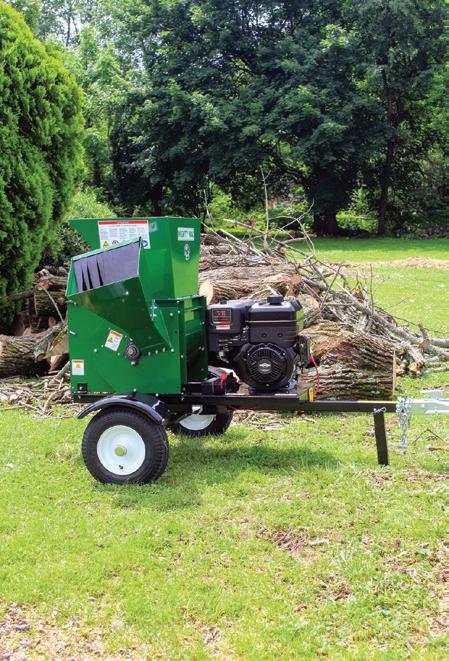




yet wonderful fact that you can use toughas-nails cast-iron cookware on the grate. (I don’t recommend any other cookware, as the re might damage it.) With this seemingly small alteration, a whole world of more convenient cookery will open up.
To successfully create a composed meal with a re grill, my rst order of business is to get everything prepared. Collect all the rewood you’ll need before starting the re — the last thing you’ll want to do is have to run and get sticks while you’re in the middle of cooking. And the best rewood is, again, smaller-diameter sticks. These will allow you to feed a steady ame without creating the huge are-ups that may come from cordwood.
Next, get all your food elements prepared as much as possible before the actual cooking begins. Even though the re is more contained, it’s still a bit of a wild card that’ll require your full attention. I use a dedicated galvanized tub and, while still indoors in the kitchen, load it up with all
the cooking oil, chopped raw food, plates, tongs, and spatulas that I’ll need while attending the fire. Again, it’s never a good situation to have to run away from your pans to fetch the salt you forgot!
Finally, get yourself some excellent oven mitts. Cast-iron pans heat up quickly, and you’ll need to be able to move them to different zones of the fire throughout cooking to prevent burning or oil overheating. As you get more accustomed to cooking with a living flame, you’ll be able to build up a “hot” side and a “cooler” side to your fire, allowing you to directly heat some pans while keeping others simmering.
As with cooking over a campfire, build your fire and allow it to burn down to some flaming, glowing embers before you begin cooking. Maintaining a low, steady burn is a lot easier to manage than dealing with a 4-foot-tall inferno. Low-burning flames will have less of a chance to flare up if the wind picks up too.
Some of my favorite foods to cook over an open flame are foods that are meant to
be cooked over an open flame. You may have tried to make zesty, smoky baba ghanouj, baingan bharta, or shakshuka on your stove, but the tepid, smokeless heat offered by electric appliances just can’t cut the mustard next to truly fire-cooked foods. I’ve found that the searing heat possible with a cast-iron skillet and a direct flame makes for amazing naan and pita. Finally, one of my favorite ways to prepare a lamb or goat curry is to roast a whole leg directly on the grate. Once nicely seared, it can be cut into bite-sized cubes and added to your simmering curry sauce, spices, and vegetables for an unforgettable dish.
Cooking Over a Woodstove

Whereas the first two methods I’ve mentioned in this article deal with the smoke and heat of direct flame, this third one is a gentler approach. If you heat your home with a metal woodstove, you may not realize that you also have a source of offgrid slow-cooking as well, for the low price of a few pieces of split hardwood.
The metal top of a cast-iron woodstove gets hot, obviously, and many folks who use wood heat keep a kettle of water atop their stoves to humidify the dry interior air. But if you can boil water, you can make a surprising number of simple dishes as well.
You can place almost any cooking metal or cooking vessel atop a woodstove, though I’ve found a pot with a lid works best. This keeps the heat working on your food, rather than escaping. A pot of water left uncovered may be steaming after half an hour, but a covered pot can come to a boil in less than 10 minutes.
As for possible dishes to cook on a woodstove, think low and slow. This cooking surface is ideal for many winter greats, such as simmered stews, toothsome beans, and all-day cooked bone broth. I’ve also used my woodstove to slowly cook down pints and pints of apple and pumpkin butter without burning it.
My favorite woodstove recipe is old chicken stew. Anyone who’s ever had to take out an old laying hen or a 5-yearold rooster knows their meat comes out like flavored rubber bands when cooked quickly not pleasant! But when put into a covered roasting pan, cozied into place with root vegetables and spices, covered with water, and simmered from dawn to dusk on a woodstove, the meat is fall-off-the-bone tender and the broth wonderfully rich. I’ve also heard from a hunter friend this is a great way to slow-cook venison.
Though it takes a bit of practice, the rewards of knowing how to partner with our ancient friend, fire, to produce satisfying and off-grid meals is something anyone would enjoy having in their skill set. There’s no better opportunity to start learning than the season that’s right before you. So, grab some sticks and a pan or two, accept some initial burned results, and get cooking!
Wren and her husband left the city and its dependency and went back to the land in the Ozarks. Every year, they’re getting closer to their goal of getting entirely offgrid, being as self-sufficient as possible, and living happily as modern peasants.





































MANAGE HEALTHY Grassland




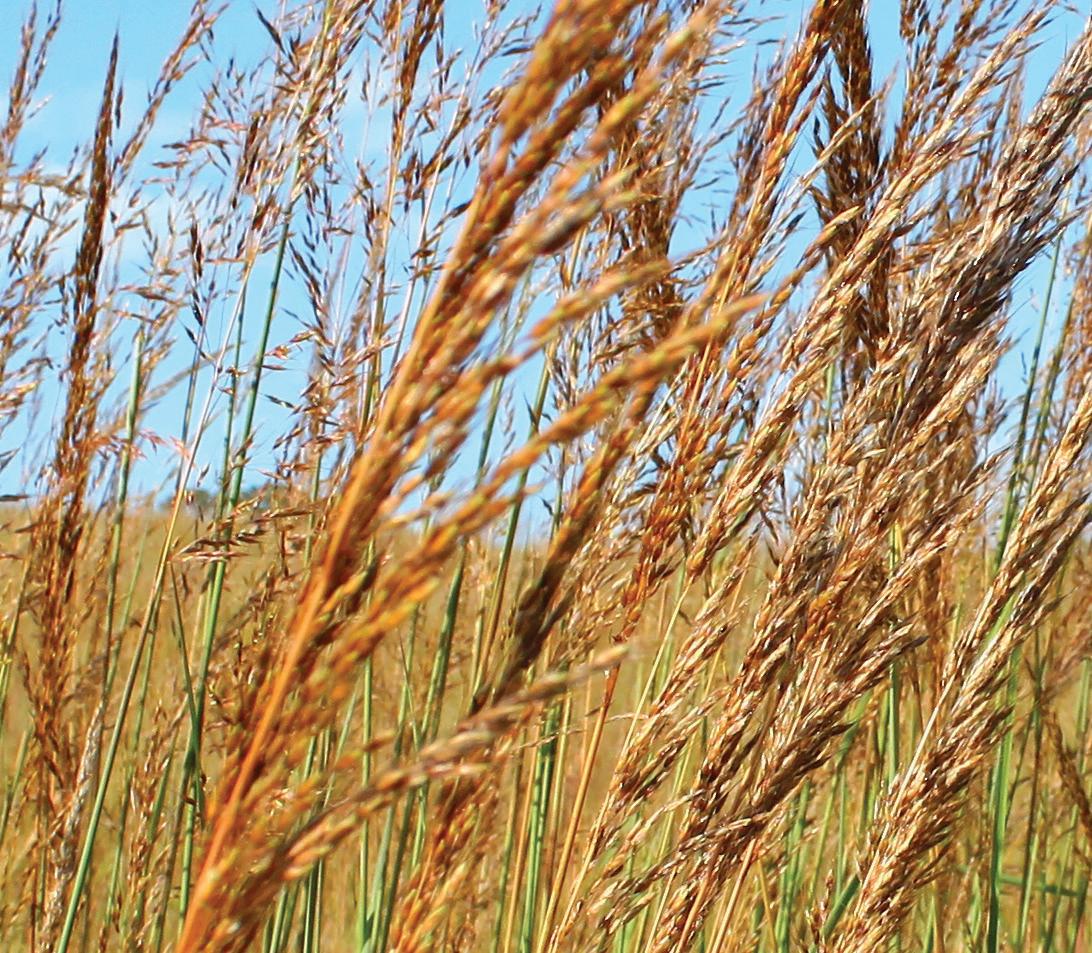



Keep the grass greener on your side of the fence with these techniques for promoting productive pasture.
By Ashleigh KrispenseIn
of a tallgrass prairie, it can seem like time stands still. Day after day, the bluestem grass sways in the breeze, and the buffalo wallows continue to look like a herd of bison passed through just the other day. Underneath this calm façade, though, an entire ecosystem is hard at work. With the right care, you can work in conjunction with that ecosystem to find a system for managing your grassland that benefits both your pasture and your animals.
Know Your Landscape
For centuries, tallgrass prairies have played a vital part in ranching and cattle production.
While these pastures can be left to their own devices, without proper management and care, they can fall prey to invasive trees and noxious weeds. As my brother-in-law, Klayton Krispense, says, “If not cared for, your productive piece of grassland can become a depressing section of wasteland.”
Doug Spencer, state grazing specialist with the Kansas Natural Resources Conservation Service, explains some of the basic principles of good grassland management: “Know your landscape

and ecological context, the needs of the plants, the needs of the animals or livestock, and work to strike a balance of meeting needs while providing additional ecosystem services,” he says. “Herbivory [grazing and browsing], fire, and climate interacted to shape Kansas grasslands.”
When looking at your piece of rangeland, consider what factors are affecting it. What kind of forage does it produce? Is it grazed regularly, or has it been overgrazed? Has it been burned recently? Are invasive weeds present? According to Spencer, you should ask yourself whether you’re fully understanding and properly utilizing all the factors contributing to the current condition of your grassland.
Evaluate Regularly
Keep a watchful eye on your grassland to help avoid any unpleasant surprises. We regularly evaluate pastures in spring and fall, before we put the cattle out to grass and then again to know when to take them off.
In early spring, we perform regular maintenance and repair to our fences, and we evaluate the pastures to see if burning would be beneficial. If a piece
of grassland is infested with small trees (such as cedars), was unevenly grazed the previous season, or was partially burned at some point, a controlled burn can help promote an even level of new growth, which helps encourage cattle to graze the entire pasture instead of favoring sections.
Pay Attention to Your Plants
Most pastures in our area of the Flint Hills consist of a blend of native grasses and forbs. Many forbs get a bad rap as “weeds,” but just because a plant is considered a weed doesn’t necessarily mean it’s harmful. Weeds can simply be unwanted plants in a particular place. According to research done by the Kansas Agricultural Experiment Station in 2012, up to 29% of a cow’s diet can consist of forbs. Before undergoing harsh treatments to remove the “weeds” from your pasture, consider whether some of them are beneficial feed for your herd.
Keep in mind, though, that some species of plants and trees can be harmful to an ecosystem, and even considered “noxious.” In grassland specifically, sericea lespedeza and musk thistle can cause concern. “Additional plants, such as teasel [common or cut-
the middleWhen evaluating your pastures, consider improvement techniques that will benefit both your grassland and your grazing livestock.
Silvopasture
A Guide to Managing Grazing Animals, Forage Crops, and Trees in a Temperate Ecosystem
Silvopasture systems integrate trees, animals, and forages in a whole-system approach that offers several benefits to the farmer and the environment. In this book, farmer Steve Gabriel offers examples of diverse current systems that include stories of oxen and pigs used to clear forested land in New Hampshire to create space for new market gardens and orchards; turkeys that are used for controlling pests and fertilization on a cider orchard and asparagus farm in New York; and a black locust plantation for fence posts coupled with summer grazing pastures for cattle in central New York. All of these examples share common goals, components, and philosophies. The systems may take several years to establish, but the long-term benefits include healthier animals and soils, greater yields, and the capacity to sequester atmospheric carbon better than forests or grasslands alone.

This title is available at Store.Grit.com or by calling 866-803-7096. Mention promo code MGRPANZ5. Item #8952.
leaf] and old-world bluestems can be county-option-designated and are also on the increase in grasslands,” Spencer says. “While not noxious, there are additional plants that could be considered invasive or obnoxious within grasslands. Some woody species to be concerned with include eastern red cedar, hedge, and locust, but several others can invade depending on what the local seed source is. The loss of grasslands due to woody plant encroachment is a serious concern across the Great Plains. When grasslands are lost, we lose biodiversity, pollinators, working lands, opportunities for hunting and outdoor recreation, carbon sequestration, and water security.”
According to Spencer, a pasture that contains quite a few weeds could indicate a large amount of bare ground, allowing weeds a place to both germinate and grow. Broomweed can come up in large quantities if the ground was bare the previous fall. Weeds can also indicate a weakened community of native plants, which can be a result of anything from drought to overgrazing.
For help identifying weeds and developing a treatment plan, contact your local county extension agent or rangeland specialist. They may even have suggestions for preventative measures you can take to avoid the issue in the future.

Sometimes, a simple step can be taken to help prevent an infestation. For example, if musk thistle is located in our pastures, we remove the entire plant

(with gloves!) and put any seed heads in a separate feed sack to be burned. If not managed properly, musk thistle can spread between pastures and cause issues for neighbors, so it’s important to keep on top of it regularly.
Know Your Soil
Healthy soil is the foundation of healthy grassland. When asked about soil health, Spencer tells people that grasslands are managed by observing only about a third of the whole situation, as about two-thirds of annual production remains underground, keeping the soil healthy and supporting the biotic community. “Complete turnover in root systems happens every three years or so and leads to high organic matter content in our grassland soils,” he says. “We make management decisions viewing a third of the situation, and our treatment of the aboveground community has a twofold impact belowground. It’s up to the manager to decide if that’s a positive or negative impact.”
According to Spencer, if you dig down into well-managed native rangeland, you’d hope to find healthy soil that’s dark in color thanks to the high organic matter content. It would be full of live roots and, as Spencer puts it, “well-aggregated, resembling cottage cheese curds.”
Not all soil is created equal, so it’s helpful to have a basic understanding of the various types of soil you might have. “Knowing your soils is part of knowing
your landscape and ecological context,” Spencer says.
According to agronomist Andy Kelsey, soil types can change within every 1 ⁄4 to 1 ⁄ 2 mile. Some examples of common soil types in our area include Irwin silty clay, clime silty clay loam, reading silt loam, and Labette silty clay.

Clay is nely textured and “sticky” if wet. It can range in color from black to gray and even yellow in some places. Sandy soil has loose particles that don’t retain water or nutrients. Loam soil has larger particles, allowing plant roots to penetrate deeper and water to better in ltrate. An example of silt soil can be found in elds where water has washed the top layer of soil into a concentrated area called a “silt bar.” Silt particles are between the size of clay and sand particles, and they can feel somewhat slippery to the touch.
To learn more about your soil, check out the U.S. Department of Agriculture Natural Resources Conservation Service’s (NRCS) Web Soil Survey ( https://WebSoilSurvey.NRCS.USDA. gov/App ) or the SoilWeb app, developed by the NRCS and the University of California, Davis, Soil Resource Laboratory ( https://CASoilResource. LAWR.UCDavis.edu/GMap/ ). Results can be detailed, even down to a speci c area of a eld.
Manage Erosion
While erosion doesn’t affect grassland production as much as it can
affect cropland, it’ll certainly change how your land continues to function.
According to Spencer, if the plant community is weakened, it can lead to bare ground, offering more place for water runoff. In areas where cattle walk the same path day after day, eventually wearing a “cow trail” into the ground, water will ow to the lowest point,
continually running down through the cow path as it cuts away dirt. Eventually, a ravine can form.
To help manage erosion, Spencer says you should maintain healthy grassland and watch for any changes in the pasture. “Identify where changes in water ow or vegetation cover are occurring or could occur, minimize the negative animal


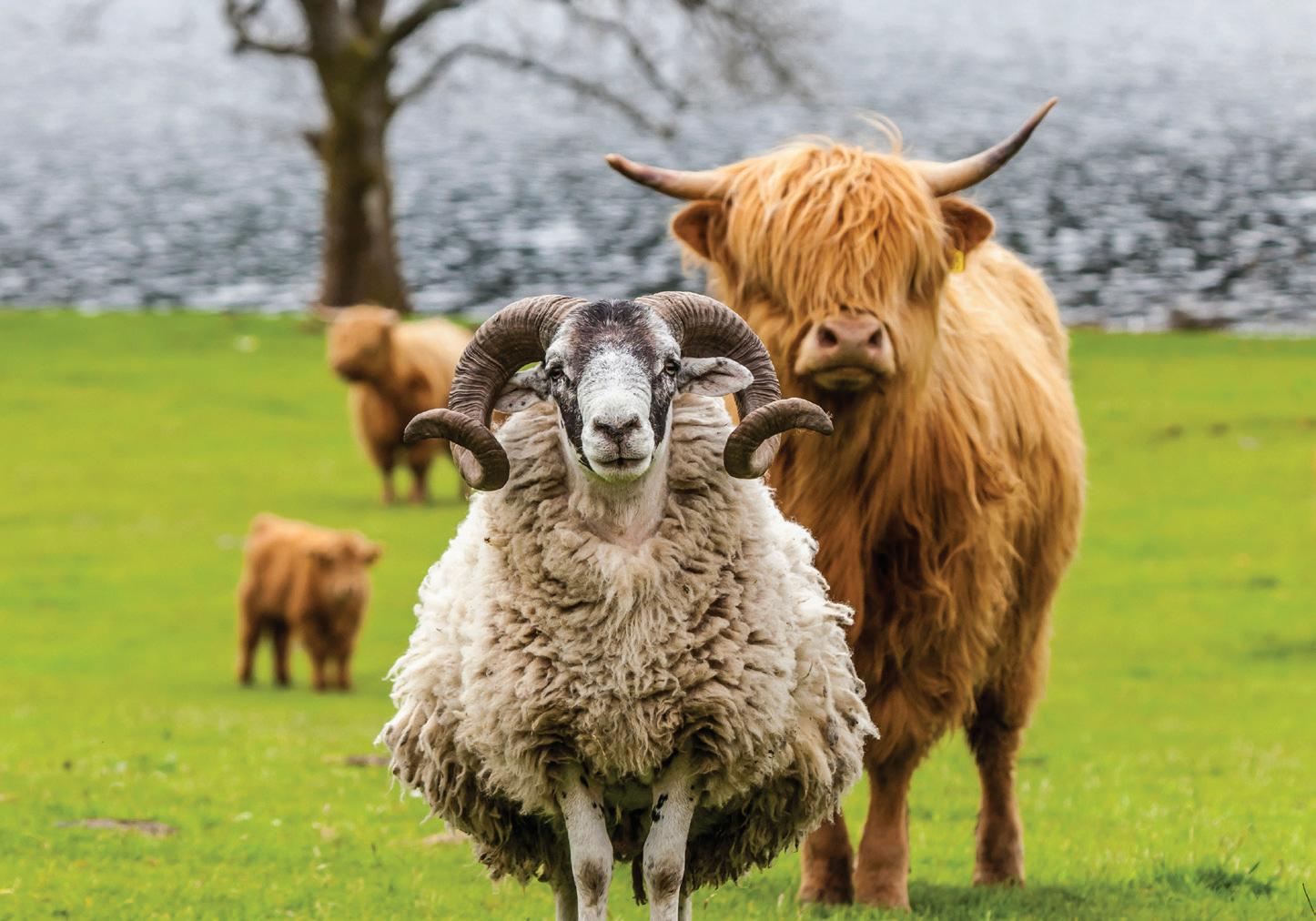

Made in the USA





disturbances, and allow vegetation recovery,” he says. “Proactive management decisions will help prevent the need for costly items, such [as] engineered structures for erosion control.”

Consider Controlled Burns




When a controlled burn is executed properly and during the appropriate season, it helps eliminate any remaining dead grass and debris from the previous grazing season, removes parasites and ticks overwintering in the grass, and promotes a more even growth of new grass. According to Kelsey, if a controlled burn is done at certain times, it can be used to target and kill specific weeds that are just beginning to grow, as well as any remaining weed seed.

While fire certainly can be helpful, it has some drawbacks. Kelsey notes that as fire burns, nitrogen and sulfur are gassed off into the atmosphere (both of which are extremely important for good growth in a majority of plants), and potassium is

















































lost as ash remaining after the fire then blows away.
As a grassland manager, weigh the pros and cons and make an informed decision before implementing a controlled burn. Consider the climate. Is it forecasted to be an extremely dry season? Look at how even the grass is. Notice if only a specific section of the pasture has been grazed and if there’s a large amount of tall, dead grass that could poke cattle in the eyes as they reach for the shorter, new growth.
Implement a Grazing System
When keeping livestock on grassland, Spencer says you must know the carrying capacity of your pasture before you decide on a particular grazing system. While you have several options to consider, he suggests implementing a system that’s manageable for both your availability and your skills. You’ll also want to choose a system that meets the needs of both your grassland and your animals.
Methods of management can change from year to year and season to season. Spencer warned against continuing with the same management style just because it worked in the past. Keep in mind the changing variables each year, whether lack of rain, changes in the sizes of animals (and demand for forage), or any change in feed production due to an invasive species moving in. For example, according to my father-in-law, Todd Krispense, a local rancher and third-generation cattleman, it can be good to stock a pasture lighter or remove the animals sooner during dry years. Keep watch on how much forage is available, and don’t automatically assume you need to burn each spring. In colder climates, if grass is overgrazed in fall before going dormant and freezing, it can be hard on the root system. To avoid this, don’t leave livestock to graze too late into the season.
Grazing systems come in a variety of different shapes and sizes, from a single animal left in a pasture year-round to an intense “mob grazing” system, where a herd is regularly rotated to a new section of grass. What we implement on our farm is a hybrid system; we stock a single pasture heavily, but we don’t leave the cattle on late into the season.
It can also be beneficial to graze more than one type of animal at a time. Klayton Krispense raises Boer goats, which tend to eat forbs, woody plants (such as buckbrush), and other unwanted pasture plant species that cattle might normally pass up in exchange for grass. I encourage you to read more on multi-species grazing systems and the benefits they offer, including reduced parasite problems and targeted plant control.
According to Todd Krispense, when managing rangeland, it’s important to keep a long-term plan in mind. Even though it might seem like a particular practice or method is profitable in the short term (such as overstocking or overgrazing), some practices can be detrimental to your grassland and will cause damage when continued for a longer period. While some producers push for more animal





productivity, an old rule of thumb for forage production is “take half, leave half.” Whether you have a single animal or an entire herd, making an effort to manage your grassland effectively will be important to the long-term health, productivity, and profitability of not only your land, but your animals too!








Ashleigh Krispense is a farmer’s wife and freelance writer from central Kansas, where she lives with her husband, Kolton, and their menagerie of critters. You can follow along with her recipes, ramblings, and farm happenings on her website, www. PrairieGalCookin.com




OUTSTANDING OKRA OKRA
A Succulent Summer Staple
Add
BullingtonOkra graces
our garden each year, standing tall beneath the ood of summer sunshine. With roots in ancient Africa, this crop has been the center of comfort foods for centuries. Okra is part of the mallow family, and it’s a relative of hibiscus, rose of Sharon, hollyhocks, and cotton. Surprising, isn’t it? Yet once you see okra’s beautiful blooms, the relation starts to make sense. The owers are creamy, open, and showy, with dark, velvety centers. After the bloom, the small and tender seedpod emerges. This is the treasure we call okra.
I’ll get it right out there: I’m a big fan of okra! I also understand that it’s one of those garden crops that gets folks on different sides of the fence. The obvious culprit is okra’s characteristic texture. Okra can be kind of slimy if it’s not prepared right, and that can be a turnoff. But there are many wonderful ways to cook with this garden superstar, and I’ll share some of my favorites with you.
Okra may be quite humbly known as a vegetable, but it’s also a superfood, growing right in the garden. It’s loaded with dietary ber and many vitamins and minerals. Speaking of the famous okra slime, this amazingly mucilaginous stuff is incredibly healthy. It helps soothe digestion.
Overflowing with Okra

Okra is extremely productive. My family’s hands-down favorite cultivar is ‘Clemson Spineless.’ It has a classic green pod, and it’s free of the typical thorn-like spines, which makes harvesting easier. It also oftentimes has us guratively waving the white ag of surrender near the end of the growing season — our freezer is bursting with bags of okra! You can also nd ‘Longhorn’ and ‘Evertender’ cultivars; true to its name, ‘Evertender’ seedpods stay tender for longer on the stalk. For those gardeners looking for a unique twist for their okra patch, try the atypical ‘Burgundy’ okra, a beautiful dark-purple cultivar.

In our garden, we direct-sow okra seeds in late spring after the danger of



this hardy and bountiful crop to your garden for stunning blooms and delicious produce.Story and photos by Maggie
frost has passed. Optionally, soak the seeds overnight to help soften the hard outer layer and to encourage germination. (Sometimes we soak our seeds, sometimes we don’t.)

To plant, start by preparing a bed. Chop the soil with a hoe to break it up, and then rake it smooth. Add fertilizer as needed. Okra loves well-drained soil that has a neutral to slightly alkaline pH. Run a hoe through your soil bed every 8 to 12 inches to form the rows, and then drop seeds into the rows. I generally like to sow okra seeds rather thickly (at least every inch) to account for the possibility of poor germination. Cover them with soil. Tamp the soil with your hoe, and you’re done. As they germinate, thin as necessary to end up with a final plant spacing of about 8 inches apart. Okra needs moderate watering and thrives in hot summers, which is exactly what we have here in Zone 7b.
Mulch or weed okra regularly while it’s maturing to combat any competing roots, but once the okra plants get about kneehigh, they’re pretty hardy. The blooms emerge near the top of the plant and are followed by the pods. Over the course of the season, the plants continue to grow taller, with most easily reaching 6 feet or more in height. The leaves and stems are prickly and will quickly irritate your skin, but some simple management can keep the pods easier to pick.

While harvesting the pods with a sharp knife, trim a leaf or two from the stalk and leave most of the leaves at the top of the plant. This will keep the stalk free from most of the side limbs and make it easier to access without getting all scratched up! As the growing season nears its end, leave some of the pods on the plant to mature and produce seeds, which you can save for the following season.
Because okra pods grow so quickly, it’s best to pick them daily. The ideal pod length is about as long as your index finger. These small pods are tender and perfect for eating. In most cultivars, as the pods grow, they develop a tough, woody structure, and at some point, you’ll hardly be able to cut them with a knife.
Now that you have a basket full of those little green pods in the kitchen, what’s next? Let’s make some comfort food!

Can ’Em, Freeze ’Em, Stick ’Em in a Stew
My go-to method for preserving okra is to freeze it so it’s ready to go in the frying oil. This is super easy. Wash the pods with water, and then cut them into 1⁄2 -to-3⁄4-inch slices. Then, put the slices in a gallon-sized freezer bag with a small amount of plain cornmeal in the bottom. Seal the bag, and shake it to coat the pieces with cornmeal. That’s it! Your okra is now ready for the freezer.
When I’m ready to cook up a batch of fried okra, I just pop open a bag and dump the desired amount into a pan of hot oil. I then fry it until crispy, adding salt to taste. It couldn’t be simpler and it’s a great dish to serve all throughout winter! Fried this way, okra doesn’t have any offensive slimy texture. Pair it with black-eyed peas, sweet pickles, and collard greens, and you’ll have a delectable feast.
The Whole Okra
A Seed to Stem Celebration
The Whole Okra is a lighthearted but informationrich collection of okra history, lore, recipes, craft projects, growing advice, and more. Join author Chris Smith as he recounts what he’s learned from various chefs, food historians, university researchers, farmers, homesteaders, and gardeners. Inside, you’ll find classic recipes, such as fried okra pods and okra soup, as well as unexpected delights, including okra-seed pancakes and okra-flower vodka. In addition to recipes, Smith researched the history of okra as a fiber crop for making paper and the uses of okra mucilage as a preservative. The Whole Okra is foremost a foodie’s book, but Smith also provides practical tips and techniques for home and market gardeners. He gives directions for saving seed for replanting, for a breeding project, or for a stockpile of seed for making okra oil, okra flour, okra tempeh, and more.

This title is available at Store.Grit.com or by calling 866-803-7096. Mention promo code MGRPANZ5. Item #9493.
I also love pickled okra. It’s so easy to add to any meal. My sister-in-law sautés sliced okra in a pan with yellow summer squash and butter for a fabulously simple side dish. Okra is also a famous addition to rich, comforting gumbos. In fact, the term “gumbo” comes from the West African Central Bantu word for okra, ki ngombo. Okra can be sliced and added to any soup for its characteristic flavor and unique and delicious thickness. If you enjoy the texture, small okra pods are excellent eaten raw with yellow mustard. Pop some onto a charcuterie board for a fun conversation starter.
I hope you’ll make room for a patch of okra in your garden. Then, give these recipes a try, and become a fan of this superfood. Happy growing!
MAGGIE’S FAVORITE OKRA PICKLES
I love making pickled okra and having it ready to serve all year long. It’s delicious, with a hint of heat. Yield: 7 pints.
4 cups water
2 cups vinegar (5% acidity)
1⁄3 cup pickling salt
2 teaspoons dill seeds
3½ pounds small, freshly picked okra pods
7 cloves garlic
7 small fresh hot peppers
1. Combine water, vinegar, pickling salt, and dill seeds in a saucepan. Bring to a boil.
2. Pack okra into hot, sterilized jars, leaving ½ inch headspace. Place 1 garlic clove and 1 hot pepper into each jar.


3. Pour boiling vinegar mixture over okra, leaving ½ inch headspace. Remove air bubbles by running a table knife or small spatula among the pods. Wipe the jar rims.

4. Cover at once with warmed canning lids and screw bands on securely. Process in boiling water bath for 10 minutes. For best flavor, allow sealed jars to sit a couple of months before serving.
We’d love to see pictures of your garden-fresh okra, or learn a new way to cook it! Share your photos and recipes with us on Facebook (@GritMagazine) and Instagram (@Grit1882).
Note: You can also use fresh dill in this recipe. Omit dill seeds and add a generous sprig or head of fresh dill to each jar.
PAN-ROASTED OKRA PODS
Traditional Southern-fried okra is a special dish to me. However, for those looking for a change of pace or for a lower-fat alternative, this savory method is delightful! The vinegar soak is intended to help reduce the slimy texture. You can skip this step if you’re in a hurry. Yield: 4 to 6 servings.
1 pound small fresh okra pods
¼ cup vinegar
1 teaspoon cooking oil
2 tablespoons cornmeal

½ teaspoon salt
¼ teaspoon paprika
¼ teaspoon garlic powder

¼ teaspoon black pepper
Fresh lemon
1. Prepare okra pods by removing stems.
2. Add vinegar to a large bowl of water, and soak okra pods in vinegar-infused water for 20 to 30 minutes. Drain off water, rinse pods, and pat dry.
3. Heat oil in cast-iron skillet over medium heat; add okra and sauté for 12 to 15 minutes, tossing gently to ensure even cooking. Meanwhile, combine cornmeal, salt, paprika, garlic powder, and black pepper in a small bowl.
4. When okra is browned on all sides, squeeze lemon juice over pods, and then sprinkle cornmeal mixture and toss to coat. Continue cooking briefly to crisp cornmeal coating. Remove to a serving dish and serve warm.
STEWED OKRA AND VEGETABLE MEDLEY
I love making this recipe in summer with fresh garden bounty. It makes a hearty side dish! Yield: 8 servings.
3 cups sliced fresh okra
3 tablespoons butter
2 cups fresh corn kernels
4 to 5 large tomatoes, peeled and chopped
½ onion, chopped
Salt and pepper, to taste
4 slices bacon, cooked and crumbled (optional)
1. Thoroughly rinse okra and drain well.
2. Melt butter in a large skillet. Add okra, corn, tomatoes, onion, salt, and pepper.
3. Cover and simmer 15 minutes, or until vegetables reach desired doneness. Stir occasionally and add more butter as needed to prevent sticking. Sprinkle with crumbled bacon, if desired.
Note: During winter, you can also make this with frozen vegetables. Frozen okra, corn, and tomatoes all work well. If you don’t have bacon but still want the flavor, substitute bacon grease for butter.
TURKEY QUINOA NOT-QUITE-GUMBO
This gumbo may not be totally traditional, but it’s deliciously hearty, flavorful, and super easy. I use cornmeal-breaded okra from the freezer to make this during winter months. Yield: 8 servings.
2 tablespoons butter
1 large onion, chopped

3 to 4 stalks celery, thinly sliced
3 large carrots, peeled and thinly sliced
2 large sweet potatoes, peeled and diced
1 quart turkey or chicken broth
1 quart whole tomatoes with juice
4 cups water
2 to 3 cups sliced okra
3 cups diced cooked turkey or chicken
½ cup quinoa
2 teaspoons salt, or to taste
½ teaspoon pepper, or to taste
1. In a large pot, melt butter. Add onion and celery, and sauté until translucent.
2. Add carrots, sweet potatoes, broth, tomatoes, water, and okra. Bring to a boil.
3. Reduce heat. Add turkey and quinoa. Simmer until vegetables are tender and quinoa is cooked, 20 to 30 minutes. Add salt and pepper to taste. Serve with cheese and homemade bread.
Maggie Bullington enjoys living on her family’s homestead in rural Alabama. When she’s not writing, you may find her gardening, crafting, cooking with farmfresh ingredients, or working with her brother, who’s the knife-maker at www.LucasForge.com
BUILD YOUR OWN SURVIVAL KIT
 By Jason Knight
By Jason Knight
In the summer of 2015, I was interviewed by a Seattle news channel about the epic survival story of 16-yearold Autumn Veatch. She was ying home to Washington from Montana with her step-grandparents when their small plane crashed in the North Cascades. Autumn survived the ery wreck with bruises and burns; however, her step-grandparents didn’t make it. The blaze destroyed any tools and rst-aid or survival kits that may have been in the plane.



Although she didn’t have any training to fall back on, Autumn remembered a few survival tips from TV programs she’d watched with her father years before. She remembered to head downhill until nding a stream, and then to follow the water downstream.

So, Autumn made her way out of the mountains by locating and following a stream, climbing down several waterfalls along the way, until the stream joined a larger creek. The water looked dirty, and Autumn didn’t have any puri cation


tools. She decided not to drink it, since she didn’t want to get too sick to keep hiking. She spent the night on a sandbar, huddled in a sweatshirt, without shelter or re. The temperature was so cold that she didn’t get any sleep. But the next day, Autumn continued to hike downhill. Eventually, the creek crossed a hiking trail that led her down to a highway and a trailhead, where she found some hikers. Autumn was then taken to a local hospital, where she was treated for dehydration and burns.

A short list of emergency gear can help keep you prepared for those times when danger threatens outdoors.
Autumn’s story is amazing and hopeful. She did her best with the circumstances in which she found herself. When she believed she wouldn’t make it, thoughts of family and friends motivated her to keep going. The will to live is a powerful factor in many survival emergencies. Despite not having any formal survival training, Autumn kept her wits and persevered. Unlike so many others, she made it out alive and returned to her family.
Autumn’s story illustrates a lesscommon survival situation where navigating out of the wilderness is preferred to surviving in place until help arrives. Had she stayed by the plane, she might have succumbed to hypothermia or dehydration, especially since searchers couldn’t nd the wreck the rst day. She made good choices, had luck on her side, and ultimately made it out alive without special equipment. Imagine how vastly better her situation would’ve been with rudimentary knowledge of survival skills, or a survival kit on hand.
A good survival kit is extremely helpful for aiding in and preventing wilderness emergency situations. It should contain tools that help you meet your needs faster and can help keep you safe. Having some gear handy can also combat feelings of
anxiety or fear that may arise during outdoor emergencies, and by increasing feelings of empowerment. Survival kits come in many varieties, from pocket-sized tins to giant bug-out bags. At Alderleaf Wilderness College, we recommend keeping a small survival kit in your daypack, a medium-sized kit in your car, and a larger kit at home.

Elements of a Basic Survival Kit



When putting together an outdoor survival kit, rst consider your needs. What’s the climate and ecology of the wilderness area you’re venturing into? What kind of background knowledge or skills do you have? How portable does your kit need to be?
In choosing the contents of a kit, the most important things to consider are the standard survival priorities: shelter, water, re, and food. Ideally, each tool in your kit should be able to satisfy multiple priorities, and each priority should be supported by multiple tools.
The following tools are considered essential components of an effective, versatile survival kit. They address top priorities for wilderness survival. A barebones, ultralight survival kit should have
Essential Wilderness Survival


As an outdoor enthusiast, you know the benefits of spending time in nature. But what happens if you get lost, stranded, or find yourself in an emergency situation?
Authored by trusted survival expert Jason Knight, The Essential Skills of Wilderness Survival will show you the most effective means of staying safe and comfortable in any outdoor challenge. Learn about survival shelters, water-purification techniques, fire-making skills, top wild survival foods, and much more through clear, concise instructions and color photos.

The Essential Skills of Wilderness Survival provides accessible knowledge for people of all skill levels who wish to increase their confidence in survival situations. You’ll discover skills that could save your life and the lives of those around you, so you can fully enjoy the freedom of exploring the backcountry without worry.
This title is available at Store.Grit.com or by calling 866-803-7096. Mention promo code MGRPANZ5. Item #12056.

at least the rst three items (compass, knife, and two ways to start re). All six items will produce a heavier, but still quite portable, kit.


Compass. This tool can help navigate you to safety. It can also ward off a survival situation before it starts by preventing hikers from getting lost — but only if combined with a map or a healthy familiarity with the surrounding wilderness area.
Knife. You can use a knife to split rewood, cut branches for a shelter,
fashion a bow-drill kit, skin animals, harvest plants, and carve other tools out of wood. A good survival knife is full tang (that is, the metal of the blade extends into the handle as one piece), has a xed blade (because folding knives are susceptible to breaking), and has a high-carbon tempered-steel blade (allowing the blade to bend instead of break). The handle should be comfortable in your hand.
Fire-starting tools. Fire can provide heat for a shelter, purify water, cook food,


and help make other tools and containers. Always include at least two different ways to start a fire in your survival kit. Usually, these are a lighter, waterproof matches, or a ferrocerium rod (also known as a “fire striker”). Having at least two different firestarting tools increases the likelihood that one of them will work in a given situation. Fire-starting aids, such as petroleum-jellysoaked cotton balls and dry tinder material, should also be included in your kit.
Wool or Mylar blanket. This handy piece of gear helps satisfy the first survival priority: shelter. It can also be used as a carrying device for debris or firewood. Wool retains its insulating faculties even when wet and is fire-resistant. A Mylar blanket (commonly referred to as a “space blanket”) is a highly reflective plastic sheet that helps retain body heat and can also be used to reflect sunlight away from the body.
Metal water bottle. A versatile piece of gear that can be used to carry, store, and collect water, a metal bottle can also be used to boil water for purification. Steel water bottles are best for this purpose. A bottle of warm water can also be held between clothing layers to help maintain body heat at night.
Emergency whistle. A lightweight, ultra-loud whistle can be used to signal for help. A whistle carries much farther than a shout and won’t tax your lungs as much. The universal signal for SOS is three blasts in a row; however, any kind of whistle blown in the backcountry will attract attention.



Additional Items
Anything beyond the previous six items will add an element of comfort to a survival experience and increase the possibility of your holding on longer in the backcountry. But additional items will also add bulk and weight, so they should be chosen carefully. A large, heavy kit has a higher chance of being left home instead of being brought into the outdoors.

Water purification. Unpurified surface water can carry harmful parasites or bacteria that will seriously hinder your chances of survival. Purification systems can take

the form of a commercial backpacking water-filtration device or a vial of waterpurification tablets. Although UV-lightbased water-purification devices are available, they require batteries and clear water to function correctly.
Cordage. This is another highly versatile item that can support multiple survival priorities. The most economical and reliable cordage material for a simple survival kit is 550 parachute cord (also known as “paracord”). Cordage can be used to lash a shelter together, as the string for a bow-drill friction fire-starting kit, or for snares, among many other things. The uses for cordage are limited only by your imagination.
First-aid kit. Helpful for patching up minor wounds, a first-aid kit is especially important for guides who lead groups as part of official outings.
Every person’s first-aid kit should vary according to their specific skill level and needs. The user must know how to apply all the materials.
A good rudimentary rst-aid kit should contain basic adhesive strip bandages, a roll of medical gauze, a pressure bandage, anti-in ammatory pain killers (such as ibuprofen), over-the-counter antihistamine medication, medical tape or duct tape, and alcohol wipes or iodine.
A kit containing the above items will be small, relatively compact, and suf cient for anything that doesn’t call for hospitalization.
Other items to consider are medications for chronic illnesses or personal health issues, an epinephrine pen if you have severe allergies, and herbal salves and remedies for minor medical needs.
Light. A headlamp or small ashlight allows for nighttime movement and activity and can be used to signal rescuers.


A light can also provide a great deal of emotional comfort and raise your morale at night, especially if you’re frightened by the prospect of being alone in the dark. Be sure to use a re as the main light source

around camp at night to avoid depleting your headlamp’s batteries.
Tarp. Shelter is your rst survival priority. A tarp can keep rain off your body, provide shelter from the sun, or be used to carry or gather water and other supplies. Many companies produce backpacking ponchos that double as serviceable tarps. For a survival kit, a tarp should be no larger than 8 feet square. Avoid the heavy utility tarps frequently sold in supermarkets, opting instead for a lightweight camping tarp found at most sporting goods stores.
Extra food. Including a small amount of emergency food in a kit is a good idea, especially for those with a history of hypoglycemia.

The best food items for a survival kit have high caloric density, are nonperishable, and don’t require cooking. Protein bars are a good choice, and one or two bars are suf cient for a personal survival kit.
Tools. A hatchet, machete, or portable folding saw can make life easier in dense, brushy terrain or when you’re processing a lot of large logs into rewood. These tools also tend to be prohibitively heavy for a backpacking survival kit. Light repair tools, such as a small roll of duct tape and a compact sewing kit, can make excellent additions to your kit.
Several more items to consider include a shing line and hooks, sunscreen, a signaling mirror, a hat, and a packable set of rain gear.
Jason Knight is director and co-founder of Alderleaf Wilderness College (www. WildernessCollege.com) in the foothills of the Cascade Mountains. A seasoned wildlife biologist and wilderness educator, he’s the author of The Essential Skills of Wilderness Survival, available on Page 48.
been checking on the chicken lately?” asked my wife, Elaine. “Isn’t it about ready to come back?”
No, we don’t have a wayward hen that periodically returns for visits. But we do have a chicken of the woods mushroom that reappears every six weeks or so on an ash stump, or on one of the long-dead tree’s roots, from late May through early November. The stump is just 15 yards from our front door, so we don’t have to go far to gather what we (and many other foragers) consider the best-tasting wild mushroom.


Widely found across North America, Laetiporus sulphureus is saprobic, meaning it grows on dead or dying wood, especially hardwoods, such as white and red oaks. This fungus is as beautiful as it is avorful, boasting dazzling yellow and orange colors on a fan-shaped body that can be a foot wide. The mushroom’s wavy margins add to its fetching appearance, as do the yellowish-white esh and yellow pores.

A great-tasting wild mushroom awaits you in the woodlands. This “chicken” needs no defeathering or deboning — just pluck it from a dead tree.
“Have you
Another plus is that sometimes when you nd one chicken of the woods growing on a tree, more may be lurking on the tree’s backside. The most chickens we’ve found on one tree is six. If you come across a hardwood harboring a number of these mushrooms, you have the potential for numerous meals from a fungus that, true to its name, has a pleasant chickenlike taste and meaty consistency.
One of the questions Elaine and I face when we come across a chicken of the
woods is whether to harvest it then or to come back later, especially if the fungus is only 6 or 7 inches wide. Jeff Huffman, a fungi fan from Roanoke, Virginia, is our go-to person for identi cation and advice on mushrooms. “Letting it grow all depends on the consistency that you desire,” he says. “Young ones will be soft, similar to a button mushroom. However, as this mushroom ages, the outer edges will stay soft, but the rest will start to become denser the closer it is to the host.
DON’T MISS IT
What comes to mind when you think “edible insects”?
In this podcast episode, we address some people’s aversions to eating insects and talk about how you can incorporate edible insects into both your diet and your pet’s. Podcast team member Kenny Coogan chats with entomologist Dr. Bill Kern and Anne Carlson, CEO of the pet food and treat company Jiminy’s.
Episode 187: Edible Insects
www.MotherEarthNews.com/Podcast/Edible-Insects




The part that’s closest to the host will be denser, tougher, and woody. The longer the chicken grows, the denser the body will become too. So, for older ones, I cut farther away from the host, because that remaining part has grown too tough and dense.”

Huffman adds that some cooks use the tougher parts to make a broth. Those same parts can also be chopped and puréed to create a creamed soup. “That’s what’s so great about mushrooms,” he says. “They’re like animals in that people have found uses for most of a mushroom, just like they’ve found uses for most of a pig or beef cattle.”
Edible Relatives
Huffman says a close relative of chicken of the woods, L. cincinnatus (known as “white-pored chicken of the woods”), is just as delicious. Some foragers think it’s even superior in taste. It thrives from the East to the Great Plains. Found typically at the base of oak trees (although it can be found over roots), L. cincinnatus features less yellow in its surface color and has white pores.
Foragers living on the West Coast and in some areas of the Southwest can also hunt for a native species of chicken of the woods: L. gilbertsonii. Like its close relatives, this mushroom favors oaks — but also thrives on eucalyptus trees. Its traits include yellow pores, a fan-shaped appearance, and a saprobic nature.

Huffman recommends severing any wild mushroom from the host, leaving behind its base. Many people believe doing so will make it easier for the mycelium to regenerate at some future date. Huffman suggests placing edible mushrooms in a paper bag or basket, as doing so will preserve the avor much better than a plastic bag would. Chicken of the woods has a tendency to attract bugs, so he likes to dunk them in salt water to eliminate the beasties before cooking.
Beware of Look-Alikes
Caveats almost always exist with mushroom species, and chicken of the
Chicken of the woods’ distinctive orange and yellow fan-shaped body can grow up to a foot wide.woods is no exception. Some people experience intestinal issues after consuming this species, especially if they ate it while they were drinking alcohol, or if the fungus was harvested from a conifer. In short, even choice edible mushrooms can cause gastrointestinal problems. Wild mushrooms should never be eaten uncooked.
With all edible mushrooms, consume only a small portion of the fungus the first time you eat it. Also, never eat an unfamiliar mushroom until it’s been identified by an expert. Join a local mushroom club to learn from experienced foragers. The North American Mycological Association (www.NAMYCO.org) is an excellent national club to join, says Huffman. It’s also a good idea to purchase field guides. Two of my favorites are the National Audubon Society Field Guide to North American Mushrooms and Appalachian Mushrooms: A Field Guide
Unfortunately, many edible mushrooms have inedible look-alikes that are toxic to humans. Especially in the East, Huffman says any look-alike appearing on a conifer shouldn’t be eaten.
One poisonous species that’s
can grow on stumps or buried wood and can fruit in clusters. I’ve misidentified jack-o’-lanterns as chicken of the woods or chanterelles from a distance, but when I come close, the vase-shaped appearance, gills, and orange flesh help identify it as a mushroom to avoid.
Once you’ve positively identified and gathered chicken of the woods, cook them up and enjoy their distinct flavor. Here are a few of our favorite recipes featuring these fungi.
CHICKEN OF THE WOODS CHICKEN SALAD
Can you have too much “chicken” in a chicken salad? You won’t think so after tasting this dish created by Elaine. As is true with many wild, edible mushrooms, chicken of the woods perform well in any salad, soup, or egg dish. Yield: 2 servings.

2 tablespoons butter or oil
½ cup chopped chicken of the woods mushrooms
2 cups cooked chopped chicken
¼ cup chopped sweet onion
¼ cup chopped celery
¼ cup mayonnaise
1 tablespoon soy sauce


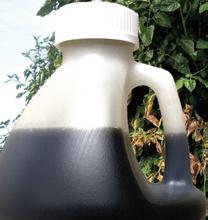
Best Natural Fertilizer On Earth
“Chicken Soup for the Soil® improves your soil by feeding the microbes and supplying all the nutrients most fertilizers neglect.”

Grow higher quality fruits & vegetables with more color, better taste, less bug infestations & disease.


Contains all the elements in the periodic table (sea nutrients, amino acids, humic, fulvic, and other herbal extracts).
All natural, toxin free, & bioavailable.
Non-leaching formula / nutrients accumulate over time.
Perfect for gardeners, growers, and farmers. humic, ranchers and farmers.

1 teaspoon lemon juice *Makes
1 tablespoon
1. In a medium skillet on medium-high heat, melt the butter and then stir-fry the mushrooms for 2 minutes. Set aside and allow to cool.
2. In a medium mixing bowl, combine chicken, onion, celery, and mushrooms.
3. Prepare dressing in a small bowl by stirring together mayonnaise, soy sauce, lemon juice, and honey.
4. Pour dressing over chicken mixture and stir well to combine. Add more mayonnaise if necessary or to taste.
5. To serve, scoop salad onto lettuce leaves and sprinkle with tomatoes.
GRILLED VENISON TENDERLOIN CUTLETS
Our friend Laura Pole, an oncology clinical nurse specialist and health-supportive chef, says, “My nephew, Dustin Pole, a south Louisiana hunter and fisherman, can cook anything that walks, crawls, flies, jumps, or swims, and it always tastes good. When I told him I was going to create a recipe for grilled deer tenderloin, he said, ‘Aunt Laura, last week I rubbed some tenderloin with some Worcestershire sauce and mustard and let it sit in the fridge for 5 days. Then, 15 minutes before I cooked it, I added a sprig of rosemary on top, then took it off right before I put the tenderloin on the hot grill. I let it sear on both sides, but left it medium-
rare in the middle. Talk about good!’” Pair this with the Chicken of the Woods Rice Pilaf recipe at right. Yield: 4 servings.
4 venison tenderloin cutlets, about 1 pound total 8 teaspoons Worcestershire sauce, divided 4 teaspoons mustard, divided 1 teaspoon salt, or more to taste 4 small sprigs fresh rosemary
1. About 3 to 5 days before cooking the tenderloins, rub each side of all cutlets with 1 teaspoon Worcestershire sauce, ½ teaspoon mustard, and a sprinkle of salt. Place in a dish, cover tightly, and allow to marinate in fridge for 3 days if the tenderloins have already been tenderized, or 5 days if not.
2. Heat grill to 450 to 500 F. About 15 minutes before placing cutlets on grill, rub a rosemary sprig on each. Optionally, you can toss sprigs onto the flames while cooking in Step 3.
3. Place cutlets on grill and sear each side for about a minute, until medium-rare or pink in the middle. Don’t overcook.
4. Remove from heat and serve hot with Chicken of the Woods Rice Pilaf. Other complementary side dishes include fresh cucumber and tomato salad and grilled peaches.
CHICKEN OF THE WOODS RICE PILAF
Laura Pole developed this recipe to pair with her nephew’s version of Grilled Venison Tenderloin Cutlets (at left). Don’t use the base of the foraged mushrooms if it’s hard and woody. Yield: 4 servings as a side dish.

1 cup white quinoa
1 tablespoon yogurt, apple cider vinegar, or lemon juice
2 tablespoons olive oil
½ cup diced yellow onion
2 cloves garlic, minced
¼ teaspoon table salt, or more to taste
1 large carrot, diced
1 small zucchini or yellow crookneck squash, diced
½ bunch kale or collard greens, destemmed and torn into bite-sized pieces
2 tablespoons butter
¼ pound chicken of the woods mushrooms, sliced into thin ½-inch-long strips
2 cups chicken stock
Salt and pepper to taste, or a Cajun seasoning blend (optional)
2 green onions, thinly sliced
½ cup chopped parsley
1. The night before cooking, rinse quinoa well and soak overnight in water with yogurt, vinegar, or lemon juice. The following morning, drain and rinse quinoa and set aside.
2. Over medium heat in a 8-to-10-inch skillet with lid, heat olive oil. Place half of onion in oil and wait for it to sizzle. Add remaining onion and continue to sauté until lightly golden. Add minced garlic and sauté for about 30 seconds. Sprinkle lightly with table salt.
3. Add carrot and sauté for 1 to 2 minutes.
4. Add squash and sauté for another 1 to 2 minutes.
5. Add kale or collard greens, toss to coat with oil, and mix with other vegetables. Sauté for 1 to 2 minutes.
6. Add butter and stir until melted, then add mushrooms and sauté until they begin to soften.
Essential Mushroom Guidebook
Learn how to identify and gather wild mushrooms and other fungi with this authoritative field guide to more than 450 species of wild mushrooms from around the world. Written by mycologist Thomas Læssøe, Mushrooms describes the life cycle and features of a mushroom, what supplies are needed for foraging, and how to take a spore deposit.

A photographic field guide forms the heart of the book, providing information on size, range, and habitat. Clear images and illustrations of specimens, along with information on what’s poisonous and what’s edible, make this the ultimate guide for mushroom hunters.
This title is available at Store.Grit.com or by calling 866-803-7096. Mention promo code MGRPANZ5. Item #10035.

7. Stir in quinoa. Add chicken stock, making sure quinoa is submerged. Salt and pepper to taste, or add Cajun seasoning, and stir well.
8. Bring to a boil, then reduce heat to a simmer. Cover skillet with its lid and cook for 15 to 20 minutes, or until the quinoa has absorbed all the liquid and is tender but still a little chewy. Don’t stir after you’ve added the broth.
9. To serve, top with sprinkle of green onions and parsley.
Bruce Ingram is a freelance writer and photographer and the author of 10 books, including Living the Locavore Lifestyle, a book on living off the land. Get in touch with him at BruceIngramOutdoors@ Gmail.com.






















RESPONDING TO ON-FARM ACCIDENTS



Knowing how and when to administer aid could help save lives.
By Loretta SorensenYounever imagined it could happen to you, but suddenly, your loved one is involved in a serious farm accident and needs your help. What can you do to assist them and provide lifesaving care they may need right away?
Call 911
LaMar Grafft, retired associate director of the North Carolina Agromedicine Institute, says the first key step is to call 911. Be prepared to give the operator the exact address of the accident and a description of where the injured person is located. Use street numbers and specific directions, such as north and south, to describe the accident site, instead of colloquial or local terminology.
If appropriate, contact a neighbor who can meet emergency responders at the farm site address and assist them in reaching the field or extended property where the accident occurred.
“Calling 911 is critical even if it appears the person or people involved in the accident are ambulatory and you believe you can transport them to the hospital yourself,” Grafft says. “What we don’t realize when something like this happens is that the injured person could succumb to a heart attack or become unconscious on the way to the hospital. If you’re driving, you have no way of assisting them or assessing the extent of their injuries.”
Don’t Risk Injuring Yourself
After calling 911, make the scene as secure as possible without putting yourself in harm’s way while waiting for emergency responders.
“This action will vary greatly depending on the nature of the injury,” Grafft says. “It’s important to stop or suppress bleeding before attempting CPR. CPR compression could make any bleeding worse.”
If electricity is involved in an accident, turn off the power source before attempting to approach the victim. Contact with the victim or even
the surrounding soil could result in electrocution for the rescuer.
If the injured person is trapped by equipment, don’t attempt to move them as that could injure them further or risk the equipment injuring or falling on you.
Administer Basic First Aid
Having a first-aid kit nearby can greatly help when responding to a minor or major wound. If there’s any doubt about whether the injury is serious enough to contact emergency help, always err on the side of caution and make the call.

“Every adult farm family member should complete a basic first-aid course and be trained to administer CPR,” Grafft says. “Anymore, CPR involves just chest compression. You may also need to give someone a couple of breaths, but knowing the appropriate way to provide chest compression could mean the
difference between life and death with a serious accident.”
Fully stocked first-aid kits are available for purchase. However, you can easily assemble your own for use in the home, office, car, or any location on the farm. A complete first-aid kit should include:
• 5-by-9-inch absorbent compress dressings (2)
• 4-by-4-inch sterile gauze pads (5)
• 3-by-3-inch sterile gauze pads (5)
• Triangular bandages (2)


• Adhesive bandages in assorted sizes
• A roll of adhesive cloth tape (10 yards by 1 inch)
• Antibiotic ointment packets (5)

• Antiseptic wipes (5)
• Hydrocortisone ointment
• Roller bandage (4 inches wide)
• Tweezers


• Sterile saline
• Isopropyl alcohol

• Gloves

Southern Exposure Seed Exchange





Saving the Past for the Future
You’ll nd us on our farm in the rolling hills of Louisa County, Virginia. You’ll nd our network of small farm seed growers throughout the U.S. Free Catalog & Garden Guide:





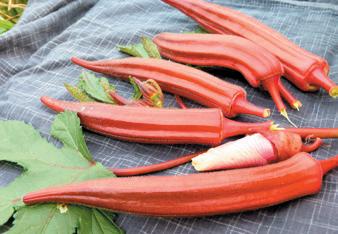





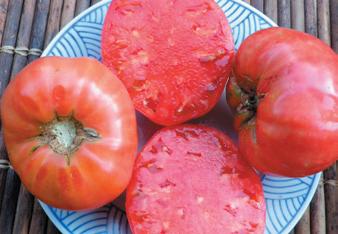
www.SouthernExposure.com

Everyone working on the farm should know where the kit is stored, what it contains, and how and when to use the contents. On an annual basis, examine the contents of all your kits and replace anything that’s deteriorated or expired. Calling in emergency medical help is necessary when:

• A wound is deep enough to reveal underlying tissue.
• The bleeding of a minor wound can’t be stopped within 10 minutes of firm, steady pressure.
• The injured person demonstrates signs of shock (which can be life-threatening).
• The wound involves the risk of tetanus or rabies.
• The wound involves nerve, ligament, or tendon damage.
• The wound involves penetration to the head, face, torso, or abdomen.
• A limb is broken.
Anytime a wound is gaping and pressure doesn’t allow for closing the wound, medical care is necessary. If the wound is contaminated by a dirty or rusty object or was caused by an animal bite, medical attention will be required. Wearing gloves, pour saline or isopropyl alcohol over the wound to wash away contaminants, and then cover with a clean dressing.
Breathing and Bleeding
Before you manage any minor bleeding, make sure the victim can breathe. Signs that breathing is an issue include:
• Agitation
• Bluish-colored skin
• Confusion
• Alterations in normal breathing pattern or rapid or shallow breathing
• Difficulty breathing or no breathing
• Gasping for air
• Panic
• High-pitched breathing noise
• Decreased breathing sounds in lungs
• Unconsciousness
If the victim is having difficulty breathing or not breathing, be prepared to perform CPR. If the victim is bleeding heavily and requires CPR, quickly apply a compression dressing and then start CPR.

To address bleeding while waiting for medical help to arrive, elevate the wound above the victim’s heart, if possible, to help slow bleeding. Maintain pressure on the wound at the same time.
Tourniquets to stop or slow bleeding are almost never advised because they may severely restrict blood flow to an arm or leg, resulting in greater damage to the limb. Use firm pressure at first.
“If a tourniquet is necessary for a major injury, don’t use things like baling twine or some type of cord to help stop bleeding,” Grafft says. “Those types of items can do further damage to tissue. If necessary, a belt or some type of strapping that’s at least 1 inch wide is a better option. An ace bandage or gauze wrapped tightly around the injured limb can also help slow or stop bleeding.”

Understand Animal Behavior
If livestock injure someone, knowledge of animal behavior will help avoid injury to anyone else attempting to assist the injured person.
“Bulls and bison are commonly involved in injury incidents,” Grafft says. “When cows are calving, cow behavior is affected. That mama cow may suddenly be fearful for her baby and take exception to the fact that you’re in her space.”
Charging is one defensive behavior of cows. Their way of removing a threat in their space is to charge and knock down whatever they perceive to be the cause.
“Typically, the way a cow injures or kills someone is to knock them down and use their head as a battering ram,” Grafft says. “They will try again and again to push you into the ground, causing broken ribs, broken arms or legs, [or] inflicting massive chest trauma.”
Always distract the cow and chase her away from the victim before attempting a rescue. Never assume the quiet cow you’ve been accustomed to won’t display defensive behavior. The best way to prevent this type of incident is to place a sturdy barrier between yourself and the cow before administering care.
“Horses respond differently to a threat,” Grafft says. “A horse will rear up,
kick you, or knock you to the ground and stomp you. The safest way to work with any livestock is to set up corrals or other equipment that will keep you safe when you’re handling animals.”
When an emergency involves livestock, designate someone to watch the animals and make sure none of them comes back to the injury site or interferes with rescue efforts.
“It’s comparable to someone keeping an eye on traf c when an injury occurs on the highway,” Grafft says. “Someone must watch to make sure traf c isn’t swerving toward the accident scene.”
Grain Bin Rescue
Unfortunately, grain bin accidents are all too common on the farm. Avoid grain bin entry as much as possible, using grain bin entry safety equipment (such as a harness or a lifeline) if entry is necessary, and thoroughly understand the way grain moves when someone walks on top of it to avoid becoming entrapped in grain.
“When someone walks on top of grain inside a bin, the grain is pulled out from underneath the person, and the body is pulled down into that void,” Grafft says. “The more the body moves, the farther it sinks down into the grain.”
A common response for someone becoming entrapped in grain is to tip their head back and yell for help as loud as they can. This instinctive response can be deadly when grain surrounding the person falls into their mouth, blocking their airway.
“If you’re entrapped or you’re on scene when someone is entrapped, keeping the mouth and nose covered will help avoid this kind of tragedy,” Grafft says. “If you must enter a grain bin, always use all the industryrecommended safety equipment, and always have someone outside who can contact help if necessary. If a person is entrapped in grain, it will take a team of rescuers to free them.”
Prevention: The Most Effective Approach
The most effective response to injury or accidents on the farm is taking precautions to prevent serious accidents. Whatever the task, understand the hazards and risks involved.

Review and implement safety practices recommended by the Occupational Safety and Health Administration’s “Agricultural Safety Fact Sheet” (www.OSHA.gov), Purdue University’s “Preventing Accidents on the Farm” (www.Engineering.Purdue.edu), and other online ag safety resources.


Being prepared for an initial response to an accident increases the likelihood of an injured person’s survival and may reduce the severity of the accident’s consequences. “Online and localized CPR courses are available through the Red Cross,” Grafft says. “The American Heart Association also offers CPR classes.” At https://CPR.Heart. org, the American Heart Association helps in locating local CPR training options, offers a course information download, and provides information for hands-only CPR, school training programs, and workplace training options. Learning options include virtual resources and trainings. Additional resources at this site include CPR facts and statistics,
“Out-of-Hospital Chain of Survival” (how to improve chances of survival and recovery for victims of cardiac arrest), and extensive CPR education resources.
“Most farm sites are within a reasonable distance of a hospital where the injured can receive full care,” Grafft says. “However, initial rst aid can help preserve life, prevent further harm, and promote recovery. Understanding the key points of safely responding to an emergency and being as prepared as possible for that response is a valuable asset for everyone who works on the farm.”
Loretta Sorensen writes from her home in southeast South Dakota, where she regularly develops agricultural safety and health articles for the Central States Center for Agricultural Safety and Health (CS-CASH) at the University of Nebraska Medical Center.
Are You Ready to Learn Blacksmithing?






Master the skill of making hooks, spoons, and tools of all sorts that you’ll use every day.


This essential blacksmith’s reference includes many projects contributed by leading blacksmiths from around the world, each featuring multiple opportunities for variation.












Modern smiths can use the first section of The Everyday Blacksmith as a reference for shop basics: safety, equipment, and techniques. In addition to these fundamentals, which are illustrated through a series of projects, you’ll also learn methods for finishing pieces.
In the second section of the book, you’ll find a step-by-step guide to a diverse range of essential blacksmith projects. Structured by category and difficulty, the instructions for these projects emphasize the accessibility of techniques, functionality of projects, and diversity of design.

The Everyday Blacksmith is sure to become every shop’s go-to reference guide.
Item #9806 $24.99










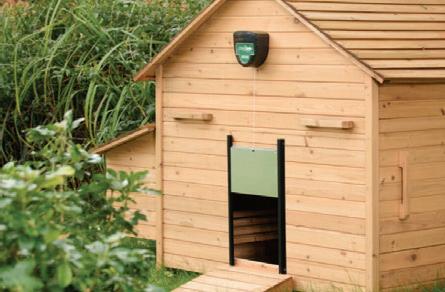














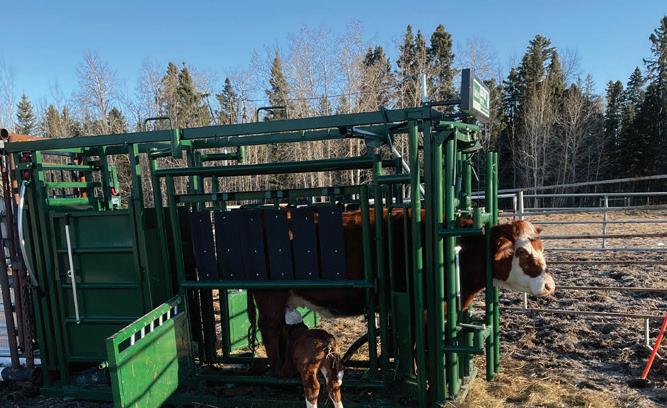








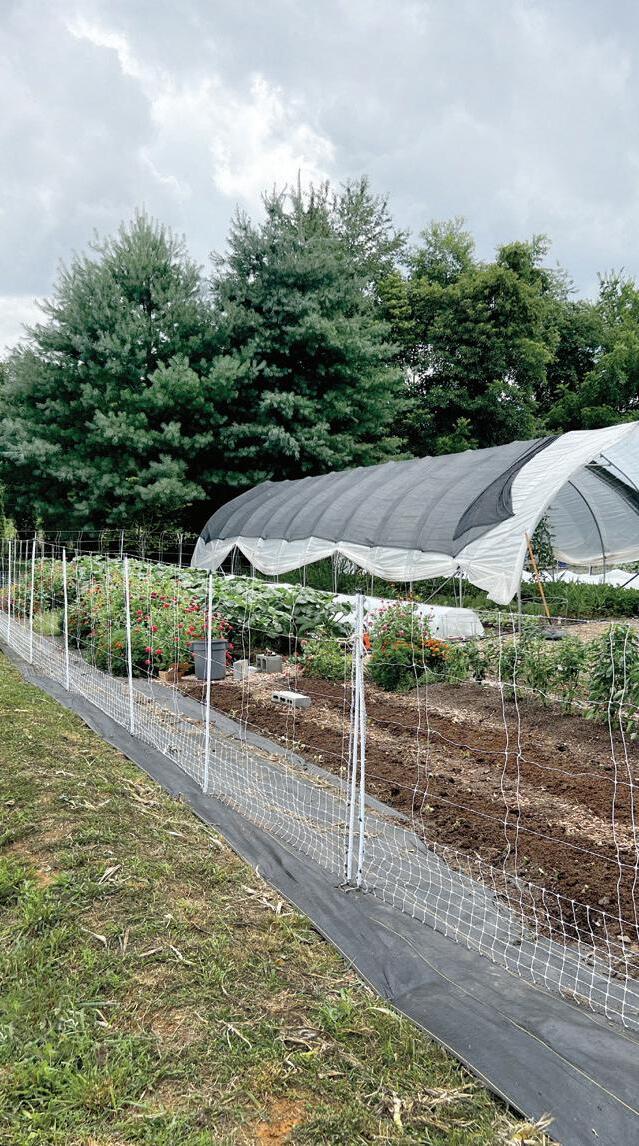









































The plant world freely provides humans with myriad ways to treat any number of illnesses and conditions that plague us. Delve into what the plants offer, and you will discover the means of bettering your life and the life of your family.


Item # 11842 $17.99

Order by calling 866-803-7096 or visiting Store.Grit.com

Please mention promo code MGRPANZ2
Ifahencould choose…
Brinsea the world leading incubator manufacturer has a full line of incubators, brooders, egg candlers, starter kits and much more!







Hatching your own chicks is fun, easy reliableandwith


















Brinsea

JUMP INTO THE World of








Goats
ONE DIY PROJECT AT A TIME!
Build Fences, Make Goat Milk Soap, Create Goat Play Structures, & Much More!


Owning and raising goats doesn’t have to be an expensive venture. With imagination, simple tools, and salvaged or bargain materials, you can make everything your goats need for their health, safety, and entertainment. Item #11406 $19.99


Order today by calling 866-803-7096 or visiting Store.Grit.com
Promo code: MGRPANZ2




• 8”, 12”, & 16” poly or aluminum pulleys
• Powdercoat finish on metal components
• Spring lock mechanism to lock pulley
• Cable guides to prevent derailing


• 4 foot galvanized elevator pole







COTTON SUN HAT: COTTAGE ROSE, GARDEN OF PARADISE, HEIRLOOM GARDEN

Garden in style with this wide-brimmed bucket hat. Choose between three exclusive prints, cottage rose, heirloom garden and garden of paradise, and display your inner gardener for all to see. A tie inside of the hat allows you to adjust the fit, making this a comfortable wear for any head size. This one-of-a-kind Womanswork hat is fully lined and hand washable cotton, meaning you can easily roll it up and pack away for wherever your gardening adventures take you.



Top: Cottage Rose #12014; Middle: Heirloom Garden #12016; Bottom: Garden of Paradise #12015
$34.00 Member: $31.99
THE CREATIVE VEGETABLE GARDENER
BASIC GARDEN TOOL
Made with the everyday gardener in mind, its triangle-shaped head and open interior minimizes dirt movement. Its high-carbon, USA steel-tempered head allows for digging through rocks, the sawtooth front and back edges cut through plant material like nothing else, and the ergonomically designed and balanced NW-ash handle makes for comfortable hand placement. Please allow two weeks for shipping. Available for shipment to U.S. continental addresses only.

GREEN: Short (less than 5’2”) #8483; Regular (5’3” - 5’11”) #8485; Long (6’ - 6’2”) #8487; X-Long (6’3”+) #8489

PINK: Short (less than 5’2”) #8484; Regular (5’3” - 5’11”) #8486; Long (6’ - 6’2”) #8488; X-Long (6’3”+) #8490
$77.00 Member: $74.95
SHORT-HANDLE 5-TINE CULTIVATOR


This cultivator is designed after the human hand. The 5 tines are shaped like “raking” fingers in the garden and the narrow space between the tines gives the benefits of fine-tuning and creating more growth potential for flowers and plants. Made in Holland from the best Swedish boron steel and an ash handgrip, this short hand cultivator is sustainably made, durable, and the perfect tool for cultivating tough soil.


Head: 3.5”L x 3.5”W Total: 11”L; 0.5lb #11292 $35.99 Member: $31.99
SLOTTED HAND SIEVE TROWEL

This do-it-all tool is ergonomically designed with slots cut into the blade to create a lighter tool and reduce friction. The unique design allows for you to easily mix your soil and additives, as well as remove larger rocks from your soil. Plus, its extra strong “well-done” design makes it one of the sturdiest trowels on the market. Sustainably made in Holland with the best Swedish boron steel and an ash handgrip, this is a must-have for any serious gardener.

Head: 6.3”L x 3.1”W; Total: 13”L; 0.5b #11289 $52.99 Member: $48.99
With The Creative Vegetable Gardener, lifestyle editor, and master gardener Kelly Smith Trimble encourages readers to widen their focus, be playful, and imagine a vegetable garden that reflects their own unique aesthetic and offers a meditative sanctuary as well as a source of fresh, homegrown food. From seed selection to garden layout and regenerative gardening practices, gardeners of all levels will find Smith Trimble’s liberating advice a pathway to making the garden a place of nourishment for the soul and creative spirit while also feeding the body.
#11952 $19.99 Member: $17.99
100 PLANTS TO FEED THE BIRDS
100 Plants to Feed the Birds provides in-depth profiles that offer planting and care guidance for 100 native plant species that provide food and shelter for birds throughout the year, from winter all the way through breeding and migrating periods. Learn about plants you can add to your gardens and cultivate, as well as wild plants to refrain from weeding out. Plant photographs and range maps provide needed visual guidance for selecting the right plants for any location in North America.

#11948 $16.99 Member: $14.99
BUG-FREE ORGANIC GARDENING

Bug-Free Organic Gardening will show you how to bring your garden ecosystem into balance so that beneficial insects and larger animals do the work of pest control for you. Learn many hands-on pestcontrol techniques, such as succession planting, shielding plants with row covers, timing plantings to bypass bugs, and so much more.

#11946 $14.99 Member: $12.99
RAISING BUTTERFLIES AND MOTHS IN THE GARDEN, SECOND EDITION

This outstanding guidebook is for butterfly lovers and gardeners who want to create a butterflyfriendly garden and support butterflies and moths to maintain healthy populations. Featuring more than 550 color photographs showing the life cycles of over 45 butterflies and moths — from egg to adult — and the host and nectar plants they rely on.
#11933 $29.95 Member: $26.95
TO ORDER, CALL TOLL-FREE: 866-803-7096 (OUTSIDE U.S. AND FOR CUSTOMER SERVICE: CALL 785-274-4365)
BEST SELLER!
ROOT CELLARING
Root Cellaring provides step-by-step advice so that anyone can learn to store fruits and vegetables safely and naturally in a cool, dark space. This book will show you a no-cost, simple, low-technology, energy-saving way to keep your harvest fresh all year long.

#539 $16.95 Member: $14.95
THE FARM GIRL’S GUIDE TO PRESERVING THE HARVEST
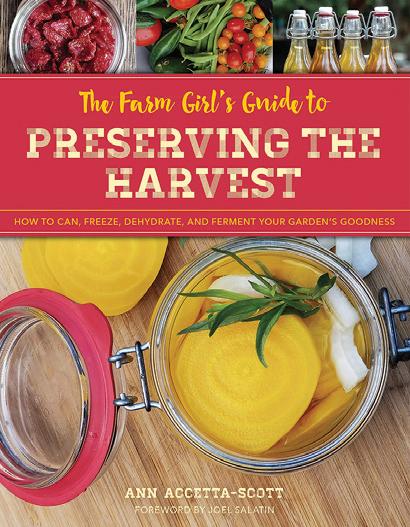

Author Ann Acetta-Scott covers all the basics on canning, dehydrating, freezing, fermenting, curing, and smoking, including how to select and use the right tools for each method. This guide takes home preservers through the beginning, moderate, and advanced stages of preserving. With more than 30 delicious and healthy recipes and Ann’s expertise and encouragement, the home preserver will build confidence in the most common methods of preserving.
#11452 $24.95 Member: $21.95

FERMENTED VEGETABLES
Even beginners can make their own fermented foods! This guide includes in-depth instruction for making kimchi, sauerkraut, and pickles, and then offers more than 120 recipes, using those basic methods, for fermenting 64 different vegetables and herbs. Inside you’ll discover how easy it is to make dozens of exciting dishes that are creative, delicious, and healthy.

#7471 $24.95 Member: $21.95
DRIED MUSHROOMS: PORCINI, REISHI, SHIITAKE
Add a touch of elegance and depth to your dishes with dried mushrooms. These dried mushrooms are sustainably harvested from the wild and handpicked by expert foragers who know how to choose the best mushrooms for customers or are sourced from high-quality, organic farms and carefully processed to preserve their potency and flavor. The drying process preserves the intense flavor and aroma of the fresh mushrooms, making them a versatile ingredient to have in any pantry. These one-ounce tins of dried mushrooms are perfect for home cooks and professional chefs alike. Please visit our online store for ingredient and caloric information and more dried mushroom varieties.
Porcini #11968 - $15; Reishi #11969 - $12; Shiitake #11790 - $15

ARTISAN DOUGH AND BREAD MAKER

With the Hamilton Beach® Artisan Dough & Bread Maker, you can create homemade breads, doughs and more with minimal effort. There are 14 settings for making everything from basic and whole grain to gluten-free and French bread. The dough settings are perfect for creating artisan and classic dough, and there are even settings for making cake and homemade jam. Easily customize your loaves to the perfect size and shade with 3 loaf sizes and 3 crust shades. Includes removable nonstick bread pan and kneading paddle that are dishwasher safe for easy cleanup. #11920 $109.99 Member: $99.99
300 BEST BREAD MACHINE RECIPES
This collection of wonderful recipes features all the information you need about baking bread using both older and newer bread machine models. You’ll find everything from traditional favorites to innovative recipes that reflect today’s tastes with tons of tips and techniques and three handy glossaries. #11157 $24.95 Member: $21.95

BEST SELLER!
THE ALL-NEW BALL BOOK OF CANNING AND PRESERVING

Organized by technique, The All New Ball Book of Canning and Preserving covers water bath and pressure canning, pickling, fermenting, freezing, dehydrating, and smoking. Straightforward instructions and step-by-step photos ensure success for beginners, while practiced home canners will find more advanced methods and inspiring ingredient twists. #8030 $24.99 Member: $22.99
CANNING JAR SAFECRATES: PINT OR QUART SINGLE, 2-PACK, 4-PACK, 6-PACK
The SafeCrate is made of sturdy, long-lasting propylene plastic construction that will safely cradle and store up to 12 of your quart or pint-size jars. The containers easily stack, helping you ensure that all of your stored food is entirely safe from harm! The crates ensure delicate glass jars can avoid cracks, nicks, and outright breakage that represents both time and money. It is even dishwasher safe. Don’t worry about cracked canning jars ever again!

NEW ITEM!
HARVESTING RAINWATER FOR YOUR HOMESTEAD IN 9 DAYS OR LESS

This complete stress-free blueprint to building an above-ground, dry rainwater harvesting system in just nine days or less reveals how you can easily collect pure, clean rainwater with minimal time, budget, and hassle. With step-by-step illustrated instructions and the amazing 7-step QuickRain Blueprint, you’ll learn exactly where to buy the right parts, how to install the right fittings, and how to connect it all together and bring rain to your home and garden.
#11945 $21.99 Member: $19.99
NEW
THE TWO-WHEEL TRACTOR HANDBOOK
Small but mighty — The Two-Wheel Tractor Handbook is a comprehensive guide to the use of two-wheel tractors for gardeners, homesteaders, landscapers, and farmers. Author, farmer, and two-wheel tractor expert Zach Loeks covers everything from why you need a two-wheel tractor and basic maintenance to innovative techniques to maximize your tractor and land use. This full-color, highly illustrated guide is a must-have tool.

BEST SELLER!
TOMATO PRESS & SAUCE MAKER

This tomato press separates seeds and skins from soft fruits and vegetables. This strainer is your best friend for home canning and making pasta. Use it to make apple sauce, tomato purees, fresh juices, salsa, baby food, jam, and more! Please allow two weeks for delivery. Available for shipment to continental U.S. addresses only.
#9468 $64.99 Member: $61.99
HENTOPIA
Hentopia will teach you how to keep chickens with less work and more joy! Free yourself from the burden of daily hen-tending tasks, and go on vacation without worrying about your flock. How? Turn your backyard into a hentopia: a chicken habitat that keeps your flock safe, clean, fed, and entertained, with less work left over for you.

#9358 $24.95 Member: $22.95
LET’S ALL KEEP CHICKENS!
Dalia Monterroso brings a fresh, inclusive voice to the community of backyard chicken keeping with this entry-level guide designed to empower anyone who’s always wanted to keep chickens but may have thought it required special knowledge and a large investment in equipment. Asserting that the backyard chicken community welcomes everyone, she addresses a broad audience, including those in urban and suburban locations. Readers will learn how to plan their flock, how to raise baby chicks, what to look for in a chicken coop, how to keep chickens healthy naturally, and more.

#11950 $16.99 Member: $14.99
THE SEVEN-STEP HOMESTEAD
In The Seven-Step Homestead, author Leah M. Webb takes readers through the process of developing their own homestead with a series of doable steps. Webb’s guidance begins with establishing one or two raised beds of the easiest vegetables to grow and gradually building up to the addition of fruit trees and berry bushes on hugelkulture mounds, a coop full of chickens, and a winter’s worth of storage crops. Stepby-step photos from the author’s own homestead, accompanied by her hardearned advice and instruction, make this a one-of-a-kind guide for anyone who aspires to grow more of their own food.
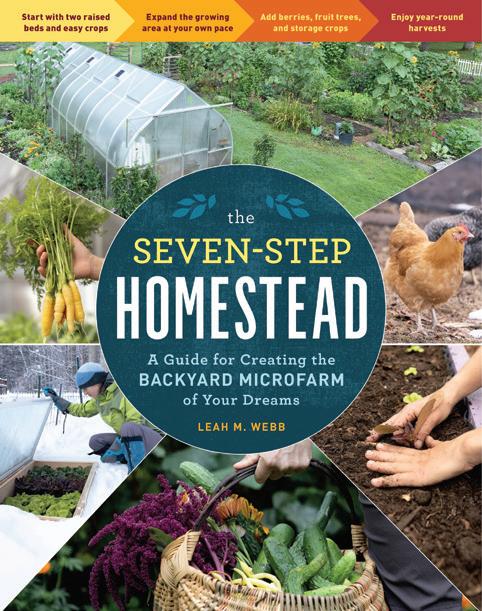
#11944 $24.99 Member: $21.99
COMMON SENSE NATURAL BEEKEEPING

With Common Sense Natural Beekeeping, learn to keep bees sustainably with limited chemical or human intervention. Based on expert advice from Kim Flottum, this book teaches holistic, sensible alternatives to conventional apiary practices, including lessons from the way bees live in the wild, management strategies that respect the natural intelligence of the bee, hive design elements that promote colony health, and more.
#11337 $24.99 Member: $21.99
TO ORDER, CALL TOLL-FREE: 866-803-7096 (OUTSIDE U.S. AND FOR CUSTOMER SERVICE: CALL 785-274-4365)

THE ESSENTIAL GUIDE TO SELF-SUFFICIENT LIVING
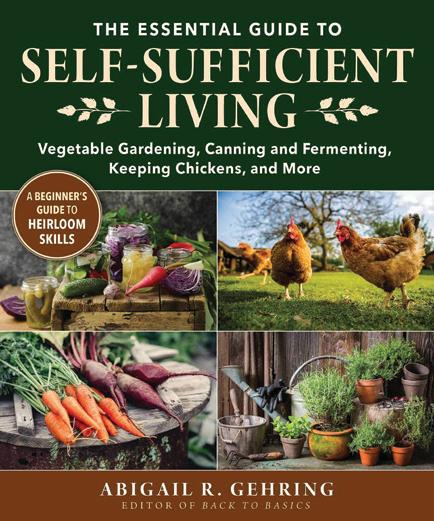
Grow your vegetables and herbs indoors in containers or a garden, raise chickens or goats, build a beehive, make your non-toxic cleaning sprays, and more! Full of sweet illustrations and gorgeous photographs, step-by-step instructions for essential skills such as building a chicken coop are mingled with country lore and old-fashioned tips and tricks. The perfect gift for anyone interested in a more selfsufficient, greener country lifestyle.
#11927 $16.99 Member: $14.99
NATURAL BIRDHOUSES
Encourage wildlife into your garden with these unique, handcrafted homes for birds, bats, and bugs. Find out how to make them, where to position them for different species, and how to provide food, nesting materials, and shelter for your wild neighbors. In Natural Birdhouses, you’ll find instructions for making birdhouses, feeders, bat houses, and pollinator houses using materials you can find locally for free.

#11930 $19.99 Member: $17.99
BUTCHERING CHICKENS
Butchering Chickens is a guide to humane small-scale processing that covers how to choose the right equipment, slaughtering humanely, customized butchering options, packaging to preserve meat quality, and more! With step-by-step photos, detailed instructions, this comprehensive handbook gives poultry raisers the information they need to make the most of their meat.

#10242 $18.95 Member: $16.95
BEST SELLER!
FARM AND WORKSHOP WELDING
A practical, visual resource for welding in farm, home, blacksmith, auto, or school workshops. Comprehensive sections describe all the major types of welds, then progress into more expert welding methods. This one-of-a-kind guide will teach you everything you need to know, from arc, TIG, MIG, and gas welding to plasma cutting, soldering, welding plastic, and more. Filled with helpful visuals and photography, detailed explanations, expert suggestions, and step-by-step directions, this go-to guide is perfect for all levels of welders.

#11356 $24.99 Member: $21.99
ADVENTURES IN AGRITOURISM

In Adventures in Agritourism, author and agritourism farmer Matt Stephens talks with six other agritourism farmers as they examine the realities and hard work involved in creating an agritourism component to help keep a small farm and an agriculture dream alive. Time to turn the page to take a step toward making your agritourism adventure a reality! Also available as an e-book!
#11910 $17.99 Member: $15.99
THE COMPLETE CROCK WATER SYSTEM

Encourage better hydration for your family by making pure, healthy water convenient. The Complete Crock Water System turns water from wells, streams, rain, and more into ready-to-drink water! This crock’s ceramic filter removes 99.999 percent of bacteria, so you’ll always have access to clean water. Please allow two weeks for delivery. Available for shipment to continental U.S. addresses only. #9287 $189.99
REPLACEMENT FILTERS: SINGLE, 2-PACK, 3-PACK
Use this replacement filter in your Complete Crock Water System for turning water from wells, streams, rain, and more into ready-to-drink water! The ceramic filter is filled with pharmaceutical-grade carbon and other special adsorbents to eliminate fluoride, lead, arsenic, and much more! Please allow two weeks for delivery. Available for shipment to continental U.S. addresses only.

Single: #9497 #59.99; 2-Pack: #10829 $109.99; 3-Pack: #10830 $149.99
THE LOST BOOK OF HERBAL REMEDIES

The lost knowledge of herbal remedies goes against the grain of mainstream medicine and avoids just dealing with symptoms. The Lost Book of Herbal Remedies targets the underlying root cause and strengthens your body’s natural ability to repair itself. With the medicinal herbal reference guide included, it’s very easy to look up your own condition and see exactly which herbs and remedies can help.
#10469 $37.00 Member: $34.99
THE TINY BUT MIGHTY FARM
In The Tiny But Mighty Farm, author Jill Ragan of YouTube’s Whispering Willow Farm teaches you how to turn a typical suburban backyard into a productive mini-farm. Learn how to grow food and, if you want, sell part of your harvest for a profit. From discovering what kind of mini farmer you want to be to selecting the best high-yielding varieties and planning out and preparing your growing spaces, it’s all covered in these pages.

#11934 $26.99 Member: $23.99
52 HOMESTEAD SKILLS
Mother Earth News’ 52 Homestead Skills follows homesteader Kimberlee Bastien, as she learns one homesteading skill per week over the course of an entire year. The book details all of Bastien’s adventures, from building a beehive and becoming a beekeeper to creating her own laundry and dish soap. Whether you already live on a homestead, are transitioning onto one, or are only thinking about it, 52 Homestead Skills will help turn your dreams into a life worth living.
#9058 $24.95 Member: $21.95

Bulls on the Farmstead

Any large animal can be intimidating, but bulls are a breed apart. Don’t let their frightening reputation stop you from taking on one of these beneficial beasts.

 By Tammy Cupp
By Tammy Cupp
With their propensity for aggressive behavior and temperamental attitudes, mature bulls can pose risks that outweigh the bene ts for small family farms. In some instances, though, you may not have the option of alternative breeding methods, such as leasing a bull or using arti cial insemination. While housing a bull de nitely brings challenges, some considerations can help you in this venture.

I’ve been raising Miniature Jersey dairy bulls and selling them to small farms across the United States for more than 17 years, and most of these folks have kept their bulls successfully. While good genes de nitely have a signi cant impact on a speci c animal’s disposition, I’ve also found the following six management considerations have great potential to increase the odds of a favorable outcome. Keep in mind that all bulls should be respected for their potential to cause injury and damage to people and properties.
1. Allow Adequate Acreage




The most aggressive bulls tend to be those kept in small quarters or not provided with space to move around freely. Consider what it’s like when humans feel backed into a corner rather than being able to

maintain personal space. For a bull, an uncomfortable situation might spark its behavioral instinct of engagement, even when a human perceives the same situation as non-threatening.


Only once did a bull’s threatening behavior result in physical injury to me. The bull was raised on an extremely small property where it came into close daily contact with humans. Being raised from birth with no room to escape direct contact with people, it learned to engage rather than step away. Because of this, the bull’s previous owner often used determined measures to force it back. As the bull matured, it began to regard humans as a source of irritation. Despite the bull’s great conformation and pedigree, its lack of regard for personal boundaries meant we were unable to keep it. We couldn’t sell it to anyone else as a herd sire in good conscience, either.
Adequate acreage for a bull doesn’t mean you need dozens of acres, but it does mean you should have enough space and facilities so both the animal and you can move about freely without constantly being in contact — about 1 acre per beast. Bulls with adequate space aren’t as likely to feel pressured and reactive. Instead of engaging physically, they’ll typically turn away and mind their own business.
You work hard on your homestead and we work just as hard to help you keep the animals in your herd or flock healthy. See our full line of award-winning products at vetericyn.com or your local animal supply store.










2. Maintain Quality Fencing
The old adage “good fences make good neighbors” is especially true when you’re keeping a bull. The nature of bulls is to test boundaries. They use their heads to butt and their weight to push around anything that isn’t nailed down, and they can destroy many objects within their reach. Bulls also push through weak fences to reach cows that are ready to be bred. Bulls have an excellent sense of smell and can detect a cow in heat up to 6 miles away. A weak fence is an open invitation for your bull to visit the neighbor’s cows a situation that probably won’t be acceptable to either party. These things don’t make a bull inherently bad. Expecting a bull to ignore its natural instincts is like expecting a bird not to sing or a dog not to bark. Sturdy fences will help keep bulls in their proper place keeping peace with the neighbors and protect your property as well as the bull itself.
Good fences are worth the initial expense and the follow-up time to maintain them. The correct setup of perimeter and cross-fencing will allow you to move cattle successfully with less effort. You can use cross-fencing to create separate but connected paddocks within the perimeter fencing, and then move your animals securely between the paddocks via gates. This will make it simple to separate a bull or cow from the rest of the herd without a lot of undue stress to you or the animal often as simple as opening a gate and allowing the animal to pass through to a new pasture once it’s been separated from the herd.
3. Create a Herd Lifestyle
As herd animals, bovines are happiest when they’re in a group. They form lasting bonds and consider their herd mates to be part of a large, extended family. Bulls have the same instinctual desires to reside with their herd, but, of course, bulls must sometimes be kept separately from cows. Examples include when heifers are too young to breed, or when cows that’ve recently calved need a rest before being bred again. The same holds true when you want all of your cows to calve during a particular season, such as a uniform spring or fall calving.
On our homestead, we typically allow the bull to remain with the herd, pulling cows when necessary. We may pull cows with similar calving dates when they’re getting close to delivery, keeping them together as a smaller herd in a separate lot until they’ve calved. We return them to the larger herd to be bred by the bull after they’ve had an adequate postpartum rest period. Young heifers (cows that haven’t given birth) are grouped by age and also removed from the herd until they’re of breeding age. In this manner, the bull remains with his core herd while we add and remove smaller groups of cows and heifers as necessary.

When it occasionally becomes necessary to remove a bull from the herd, we pasture him with several steers. Under this arrangement, it’s not uncommon for a bull to walk the fence lines and fret about not being with the cows, even though he has other herd mates.

4. Handle Bulls Infrequently
We prefer to purchase bulls that haven’t been haltered and lead-trained. We walk and work among all of our cattle daily, and they become familiar and comfortable with humans from the time of their birth. But our calves are dam-raised, as bottle-feeding and even grain-feeding bulls may increase aggressive behavior toward humans. By purchasing damraised calves with great grass-fed genetics and keeping bulls that can maintain their weight without being grained daily, we can distance ourselves from our bulls.
Bulls that’ve been raised as pets or handled daily are more likely to approach humans and insist on having their way. They may use their head to push you around. Although this type of behavior may be cute when the animal is small, it can cause serious injury to humans when done by a mature bull weighing up to several thousand pounds. Headbutting, pushing, mounting, and riding are instinctual and acceptable behaviors within the herd, but unacceptable and dangerous when directed at humans.
Consider this expert advice from animal behaviorist Temple Grandin, who wrote in her 2006 updated report “Preventing Bull Accidents” for Colorado State University, “The most dangerous dairy bull is a bull that has not been properly socialized to his own kind [emphasis added]. When a young bull calf becomes mature at age two, he needs to challenge the top bull in the herd. If the bull calf has been raised alone and has
not had the opportunity to interact with other cattle, he thinks he is a person and he wants to exert his dominance over the ‘herd.’ This can result in dangerous attacks on people.”
Grandin continues, “Ed Price at the University of California found that bull calves raised in groups were much less likely to attack people than bull calves raised in individual pens. Bull calves raised on a cow were the least likely to attack. When they are raised with their own kind, they know who they are and they are less likely to think that people are part of the herd.”
5. Observe Bovine Behavior
If you choose to keep a bull on your property, you should work to understand the animal’s natural instincts and needs. Spend time in the field observing bovines. Pay attention to how they interact with one another to better understand how a bull might react in any given situation. Know

the subtle signs of an aggressive or agitated bull before it reaches the engagement level. For example, a bull will present itself broadside to another bull to display its strength and to give the competing bull a chance to submit without a fight. Waiting until the bull is lowering its head, bellowing, and pawing the ground in anticipation of charging may be too late for removing yourself from potential harm. Another benefit to understanding bovine behavior is that it can decrease your stress level and help you exhibit quiet, calm confidence without being rash or aggressive around bulls. This, in turn, will lower the bull’s stress level and make it more cooperative. Neither overconfidence nor great fear are ideal in a bull’s presence. You can access excellent resources on bovine behavior through a simple online search. Grandin’s website (www.Grandin.com) includes some of her research projects. I also recommend her book Animals Make Us Human,
which dedicates an entire chapter to understanding bovine behavior.
6. Reduce External Stimuli
If possible, house only one bull at a time. While some mature bulls learn to live in peace with one another, others find it difficult to even share a fence line with a neighboring bull. The bulls can become stressed and physically weary from constantly posturing and bellowing across the fence. They can damage fences and injure one another if they do manage to get together. If possible, house your animal in a different area from your neighbor’s bulls.
Tammy Cupp and her husband, Mike, raise and train dairy cattle on 50 acres in the Blue Ridge Mountains. Follow them on Instagram (@Maplelawn_Farm) and Facebook (www.Facebook.com/ HomesteadDairyCows).





































LIVESTOCK EXCHANGE
CATTLE
MINIATURE TEXAS LONGHORNS For sale in Texas. TLBAA registered Miniature and small framed Texas Longhorns. Great for pet or show. 941-374-1856 www.Mini-TexasLonghorns.com
POULTRY
FREE CATALOG. Chicks, Turkeys, Ducklings, Goslings, Guineas, Gamebirds, Bantams, Equipment. Hoffman Hatchery, Box 129L, Gratz, PA 17030; 717-365-3694; www.hoffmanhatchery.com
COUNTYLINEHATCHERY.COM Best assortments available. Chicks, ducklings, goslings, turkeys, guineas, peafowl, and hatching eggs. Coggon, IA. 319-350-9130.
HARPER’S GAMEFARM, Bobwhite Quail and Ringneck Pheasant, Eggs, Day Old Chicks and Flight Birds. Call 806-435-3495 or 0528 or check out www.harpersgamefarm.com
POULTRY
www.heartlandhighlandcattleassociation.org

417.733.3201

GOATS
D&E DAIRY GOATS ALPINES, Saanens. Selling 200 plus head annually, breeding bucks and does available. 319-350-5819. Facebook D & E Dairy Goats.
POULTRY
Free shipping 1-day shipping (to most states) metzerfarms.com


FREE COLOR CATALOG 203 varieties shipped to your local post office, chickens, rare breeds, bantams, ducks, geese, turkeys, guineas, pheasants, quail, supplies and videos. Since “1936” Cackle Hatchery® PO Box 529, Lebanon, MO 65536, 417-532-4581. cacklehatchery.com

JOHNSON’S WATERFOWL 36882 160th Ave. NE Middle River, Minnesota 56737. 218-222-3556. www.johnsonswaterfowl.com
Breeds: Call Ducklings. White, Snowy, Pastel, Grey, Penciled and Black or Blue Bibbed.







SHEEP
MARUSHKA FARM’S YOUR SOURCE for CVM/Romeldale breeding sheep, raw fleece, roving, yarn and sheepskins. 570-490-4759; visit www.marushkafarms.com
UNITED HORNED HAIR SHEEP ASSOCIATION, INC. Non-profit organization representing and registering Black Hawaiian, Corsican, Desert Sand, Mouflon, Multi-horned Hair, New Mexico Dahl, Painted Desert, American Heavy Horned and Texas Dall Sheep. www.unitedhornedhairsheepassociation.org uhhsa@yahoo.com 937-430-1768.-
YARROW DELL FARM, Lauren & Matt Kuckkahn, Hayden, CO. yarrowdellfarm@gmail.com California variegated mutant sheep. Registered & unregistered CVM’s, Icelandic chickens, Livestock guardian dogs.
717.336.4878
www.freedomrangerhatchery.com
sales@freedomrangerhatchery.com

WE SPECIALIZE IN FREEDOM RANGER CHICKS; these TriColored & Red feathered chickens grow to 5-6 lbs in 9-11 weeks. We also offer Novogen Brown egg layers, French Guinea Keets, Silkies, Khaki Campbell Ducklings, and White Muscovy Ducks.

CLASSIFIEDS
ALTERNATIVE ENERGY
POLAR G-Class Best Downdraft

OUTDOOR WOOD FURNACE

The industry leader in proven clean burn technology
• All Fire no smoke.
• Combustion efficiency 99.5%
• Burns up to 60% less wood
• 7 industry firsts
• Carbon neutral

• Oldest renewable energy.

• Compatible with off-grid use
PORTAGE and MAIN Best Updraft
CONTACT
Ultimate Outdoor Furnace LLC
Les Radcliffe 507-254-0622
Polar Furnace Factory Rep Dealer/ Agent opportunities
www.ultimateoutdoorfurnace.com
PUMP WATER UPHILL. No gas or electricity with Ram or Solar Pump. Free Energy-Sun or Gravity. 800-227-8511. www.theramcompany.com
COINS
www.TreasureChestMint.com
(844) 577-5388
Gold & Silver: Bullion & Coin

Lowest retail prices in the USA!
Send SASE for product list. 209 W 3rd Street Roswell, NM 88201

CRAFTS
SEATWEAVING SUPPLIES, chair cane, reed splint, Shaker Tape, fiber & natural rush. Complete line of basketmaking supplies. Waxed linen cord. Royalwood Ltd., 517-MEL Woodville Rd., Mansfield, Ohio 44907. 800526-1630. www.RoyalwoodLtd.com
FERTILIZER
VITAZYME - OMRI approved biostimulant helps plants utilize nutrients allowing them to grow to their genetic potential. Sold world-wide. PlantDesigns.com/ vitzayme. 800-728-2716 for pricing, information & ordering.
FOOD PRESERVATION
MAKE JAM & JELLY with low amounts of any sweetener. No Sugar, Preservatives, or GMOs At natural food stores or www.pomonapectin.com 559-760-0910


FREE
SOON Church/Government uniting,suppressing RELIGIOUS LIBERTY enforcing NATIONAL SUNDAY LAW. Be informed!
TBSM, Box 374 , Ellijay, GA 30540 tbsmads@yahoo.com 1-888-211-1715.
GARDENING/RELATED PRODUCT


SAVE YOUR SOLES
CALL 866-848-5416
TO ADVERTISE IN THE NEXT ISSUE OF GRIT
$17.99 | ITEM #9949 Call 866-803-7096 or visit Store.Grit.com Promo code: MGRPANZ2
Get Inspired! 80 + healthy low-sugar recipes At Bookstores & Online
FEED
NATURE’S BEST provides premium ingredients and customer service manufacturing organic, non-GMO feed across North America. Nature’s Best knows what is important to their customers and continually strives to provide trusted products and healthy, innovative options from poultry to livestock feeds.

FREE
FREE BIBLE STUDY COURSE Write: Know Your Bible, Box 157, McEwen, TN 37101.
DIG-RIG Shovel Attachment Makes digging easy Made in USA $17.24 Shipping Included. Order Now 256-718-0676. 4140 Helton Dr., Florence, AL. 35630. www.digrigshovel.com

SCYTHESUPPLY.COM European scythes. Mow where your tractor can’t go. Custommade handles(snaths). 496 Shore Road Perry, Maine 04667 207-853-4750, Free Catalog. www.scythesupply.com, FREE hat with scythe outfit: use code GRT at checkout.
GIFTS MADE IN THE USA
Old Fashion Hand Made CLOTH DOLLS, Sunbonnets, Doll Clothes, American Made in Kansas. Free Catalog. Shipped only by US Postal Service. 913-856-6757

CLASSIFIEDS
GREENHOUSES
SIMPLY SOLAR GREENHOUSES

8’, 15’ and 28.5’ models. One piece design. Resistant to severe weather.
SOLAR TIME TRACKER
Tracks the sun across the sky. Many packages available.
866-478-4050
Come See Us at the Mother Earth News Fair West Bend, WI Sept. 16-17, 2023
BUILD WITH PVC

HOUSEHOLD PRODUCTS
COOKIE CUTTERS Order our catalog now for only $10 (Refundable via credit voucher when your total orders for the 2023 calendar year reach $25.00) Over 700 shapes, designs, & sets covering all holidays & many subjects. Mail check, money order to: Cape Cookie Cutter Company, PO Box 424, Cape Girardeau, MO 63702.
LIVESTOCK
FISH & POND SUPPLIES: Large selection of lake, pond and watergarden supplies. Free catalog! Stoney Creek, Inc., Grant, MI. Since 1970 (800) 448-3873.
www.stoneycreekequip.com

LIVESTOCK EQUIPMENT

MUSIC
GOSPEL PIANO CDS Hymns, gospel songs from days gone by! All instrumental (no singing). Great for retirees, housewives, quilters, farmers, travelers, everyone! Free brochure. Jacky Campbell, 216 Spokane Rd, Natchez, MS 39120. bennycampbell495@yahoo.com
PERSONALS
CHRISTIAN SINGLES CATALOG. Photos. Penpals. Sample $1. Singles, Box 310-GT , Allardt, TN 38504. 931879-4625. www.nicesingles.com
PLANTS, SEEDS, FLOWERS
POULTRY
IDEAL POULTRY BREEDING FARMS, INC.
Supplying quality backyard poultry since 1937.
www.idealpoultry.com 1-800-243-3257.

MYERS POULTRY FARM - FREE CATALOG. Chicks (9 meat varieties), Ducklings, Goslings, Turkeys, Guineas, more. 966 Ragers Hill Road, South Fork, PA 15956, 814-539-7026. www.myerspoultry.com
SOUTHERN EXPOSURE SEED EXCHANGE
-Specialized Fittings-Free Plans -
-Snap Clamps & PVC KitsCirco Innovations, Inc.
877-762-7782
www.circoinnovations.com
HAND PUMPS
HAND PUMPS: All stainless steel for your water. Well or cistern. 5 models to choose from. No electric needed. For more information write to Jonas & Mattie's Stainless Hand pumps, 564 Clyde Marengo Rd. Clyde, NY 14433.
HEALTH
100% ORGANIC BLACK SALVE
Tablets and Salve
HERBAL PLUS PRODUCTS
1-800-996-3203
herbalplusnv@gmail.com
1-866-443-7444
LakelandFarmAndRanch.com

MACHINERY, TOOLS, SUPPLIES
Open-pollinated, Heirloom & Organic Seeds & Garlic selected for flavor and local adaptability. Free Catalog 540-894-9480. www.southernexposure.com

POULTRY
ALL-NATURAL ODOR CONTROL or #1 Coop Deodorizer on the market www.sweetpdz.com
THE EGG CARTON STORE Best Prices, selection, high quality. 40 years of egg packaging and marketing expertise! Egg Cartons, Filler Flats, Stamps, Egg Cases, Nesting Boxes, Supplies, Poultry Care, Custom Cartons and Labels Call for GREAT wholesale/pallet quantity pricing! 866-333-1132. FREE SHIPPING on all cartons and filler flats.
WWW.EGGCARTONSTORE.COM
CROSSCUT SAWS: Saw tools, knives, firewood-cutting, people-powered tools. Catalog $1.00. ($3.00 Canada/ Overseas). Crosscut Saw Company, PO Box 7875, Seneca Falls, NY 13148; 315-568-5755; CrossCutSaw.com

GO TO WWW.CHICKENDOORS.COM for the best automated door on the market or call 512-995-0058

NRR HATCHERY has been a family owned and operated farm in Northeast Oklahoma since 2013. 1 Day Old Chicks, Hatching Eggs, Fresh Eggs, Mealworms and Farm Goods. Local Pickup and Shipping Available. For more information visit our webiste at www.nrrhatchery.com

FREE COLOR CATALOG 203 varieties shipped to your local post office, chickens, rare breeds, bantams, ducks, geese, turkeys, guineas, pheasants, quail, supplies and videos. Since “1936” Cackle Hatchery® PO Box 529, Lebanon, MO 65536, 417-532-4581. cacklehatchery.com

POULTRY
HATCHING YOUR OWN CHICKS
is fun, easy and affordable with Brinsea Forget Styrofoam incubators and watch your eggs hatch every time. Quality incubators since 1976durable, easy to clean, user friendly digital controls and 3-year warranty. Free color catalog. www.Brinsea.com

1-888-667-7009.
KEEPING YOUR FLOCK SAFE has never been easier or more reliable. With only one moving part, no mechanical switches and no calibration ChickSafe are the ultimate rugged, fuss-free automatic coop door openers with 3 year warranty.


www.Brinsea.com


1-888-667-7009.
CHECK OUT OUR AD IN THE MARKET PLACE!!

POULTRY





LOCAL HENS FIND GOOD STUFF

Grown nearby. Join more than 3,000 other farms and connect directly with consumers by listing your farm. Your FREE farm profile can showcase products with farm ph++otos, your farm story, and google map locations where you sell. Made for ALL farms and food types.
WWW.LOCALHENS.COM


SEPTIC
field! Accelerator by Dr. Pooper Drain Field Cleaner is a revolutionary non-toxic commercialstrength septic treatment that clears organic solids from septic tanks and drain fields. Money-back-guarantee! Order at DoctorPooper.com

A



Guide to Keeping Chickens

Melissa Caughey shares her advice in an engaging way so that kids understand what it means to keep chickens and what kind of housing, food, equipment, and care the chickens will need to thrive.
Item #7467 $16.95
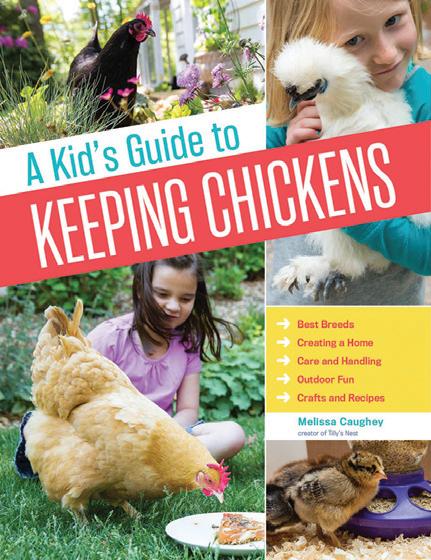
Better than cannabis, better than CBD
New Joint-Supporting “Miracle Oil” Capsule Delivers Hip, Knee, and Shoulder Comfort in Just Days

Thousands of Americans are rediscovering normal freedom of movement thanks to a “miracle oil” capsule that’s outperforming hemp in promoting joint comfort.
According to the official figures from the CDC, more than 58 million Americans are living with joint discomfort. This epidemic has led to a search for alternative approaches – as many sufferers seek relief without the harmful side effects of conventional “solutions.”
Anti-aging specialist Dr. Al Sears is leading the way with a new formula he calls “the most significant breakthrough I’ve ever found for easing joint discomfort.”
The capsule is based on a “miracle oil” historically treasured for its joint healthsupporting properties. Marco Polo prized it as he blazed the Silk Road. And to this day, Ayurvedic practitioners rely on it to promote optimal joint health.
Now, with a modern twist backed by science, Dr. Sears is making this natural solution for joint health available to the public.
Your Body’s Hidden “Soothing System”
Joint health research changed forever with the discovery of the endocannabinoid system (ECS) in 1992. Up until that point, research on cannabinoids focused on psychoactive effects. Now, scientists were looking at a new way to fight occasional aches and pains.
Your ECS serves as a central “signaling system” that tells your body how to react to things you do every day. It controls several critical bodily functions such as learning and memory, sleep, healthy immune responses – and your response to discomfort.
A recent study revealed a direct link between the ECS and creaky, sore joints. Researchers at the University of Edinburgh studied the aging of mice with endocannabinoid deficiencies versus “normal” mice.
As they aged, the deficient mice had a whopping 60% more joint degeneration than the mice with a healthy ECS.
As the name suggests, the ECS responds to cannabis. At the time it was discovered, scientists assumed that was the best way to support it. But thanks to Dr. Sears’ all-natural solution, you can power up your ECS without marijuana.
“Calling it the ‘endocannabinoid system’ was a misnomer from the very beginning,” Dr. Sears explained. “Modern research reveals that you don’t need cannabis to activate this incredible system. You don’t need to ‘get high’ to get joint relief.”
A scholarly review found that plants and herbs that don’t produce mind-altering effects can support the ECS and help it maintain its healthy functions.
This includes common foodstuffs, such as kava, chocolate, black pepper, and most significantly – the star ingredient to Dr. Sears’ own Mobilify formula - frankincense.
Modern scientists say this natural ingredient meets “cannabinoid tetrad” – the signs used to determine if something supports the ECS. While it doesn’t produce a “high” like cannabis does, it binds to the same receptors to support a healthy response to discomfort.
All the Benefits of CBD –Without Cannabis Indian frankincense, the chief ingredient in Mobilify, has been shown to provide all the benefits of cannabis without any feelings of sluggishness or sleepiness.
And studies show that users don’t have to wait long for the comfort they’re looking for.
In a study published in the International Journal of Medical Sciences, 60 patients with stiff knees took 100 mg of Indian frankincense or a placebo daily for 30 days. Remarkably, Indian frankincense “significantly” supported healthy joint function and relieved discomfort in as little as five days.
Additional research linked regular use to lasting comfort.
In another study, 48 participants were given an extract made from frankincense for 120days. When the results came in, researchers determined the extract strongly supported joint comfort – especially in the knees.
These results were all achieved without marijuana. Research continues to back up the idea that you can support smooth, strong, and healthy joints naturally – without tiredness or sluggishness.
Get Moving Again with Mobilify
Mobilify has already helped thousands of Americans stay on their feet and breeze through
their daily activities with ease.
One user even reported getting results the same day it was used.
“Mobilify really helps with soreness, stiffness, and mild temporary discomfort,” Joni D. said. Larry M, another user, compared taking Mobilify to living a completely new life.
“After a week and a half of taking Mobilify, the discomfort, stiffness, and minor aches went away…it’s almost like being reborn,” he said.
Dennis H. said it helped him get back to his favorite hobby.
“I can attest to Mobilify easing discomfort to enable me to pursue my golfing days. Definitely one pill that works for me out of the many I have tried,” he said.
How to Get Mobilify
Right now, the only way to get this powerful, unique Mobilify formula that clobbers creaking joints without clobbering you is directly from Dr. Sears. It is not available in stores.
To secure your bottle of this breakthrough natural joint discomfort reliever, buyers should call with Sears Health Hotline at 1-800-3347142. “The Hotline allows us to ship the product directly to customers.”
Dr. Sears believes in this product so much, he offers a 100% money-back guarantee on every order. “Just send me back the bottle and any unused product within 90 days, and I’ll send you your money back,” said Dr. Sears.
The Hotline will be taking orders for the next 48 hours. After that, the phone number may be shut down to allow them to restock. Call 1-800-334-7142 to secure your limited supply of Mobilify. If you are not able to get through due to extremely high call volume, please try again! Call NOW to qualify for a significant discount on this limited time offer. To take advantage of this exclusive offer use Promo Code: MBGRIT2 when you call.
“Everyone welcome, if you would, these nearly famous poultry pickers, Chickens of the Woods.”



“Hey, I thought we were the Cornbread-Fed Bluegrass Ramblers?”


“Last month, we were, son. Did you see the table of contents? There’s a story in here about mushrooms. Listen to me — art has to adapt. Hit it, Maybelle; ‘Rotten Oak Stump’ in the key of G.”

Our Passion is to Fuel Theirs.
Your loyal companion is just as excited for the hunt as you are. Let VICTOR Pet Food help them get out there and thrive this season. Each bag, including the exclusive Realtree® line, features VICTOR’s proprietary VPRO® Blend of vitamins and supplements. With the optimal protein-to-fat ratios to fuel active hunting dogs plus added glucosamine and chondrotin for joint support, these formulas are designed to keep hunting dogs running strong all season long – on and o the field.








Find the right formula for your partner at victorpetfood.com






